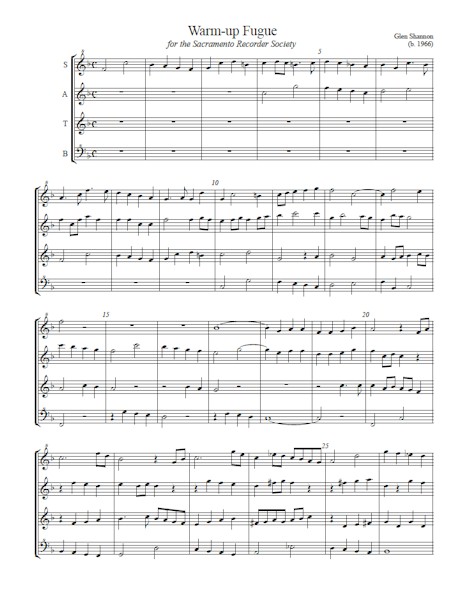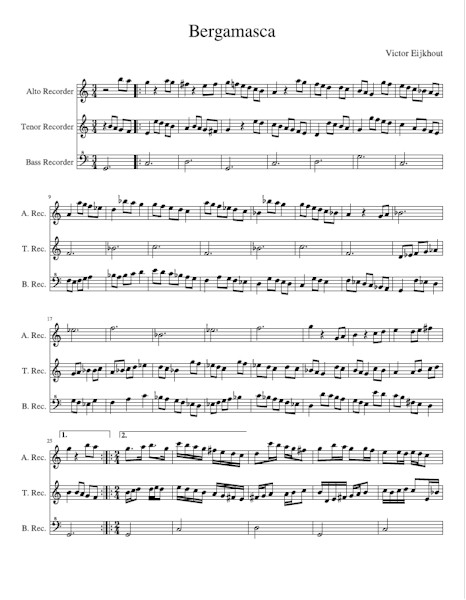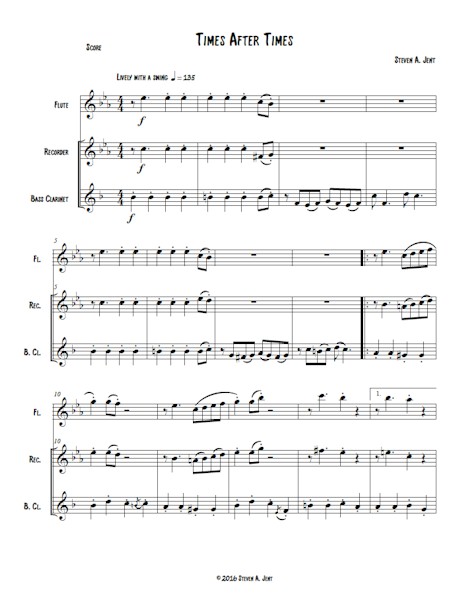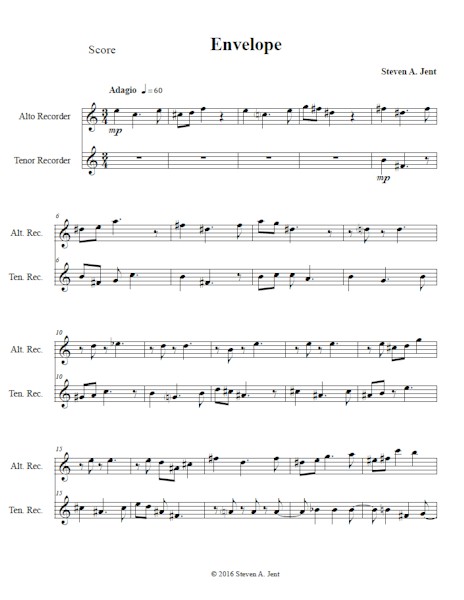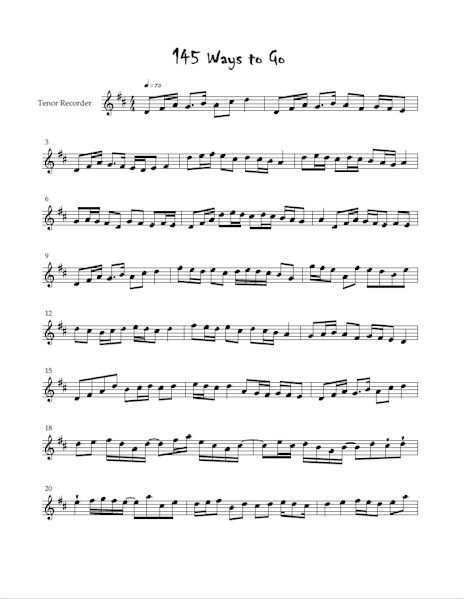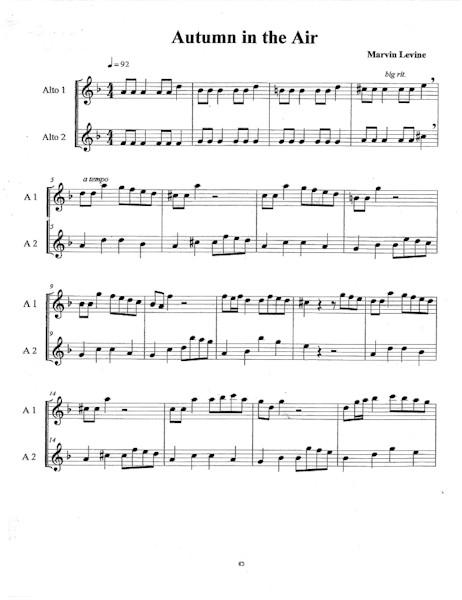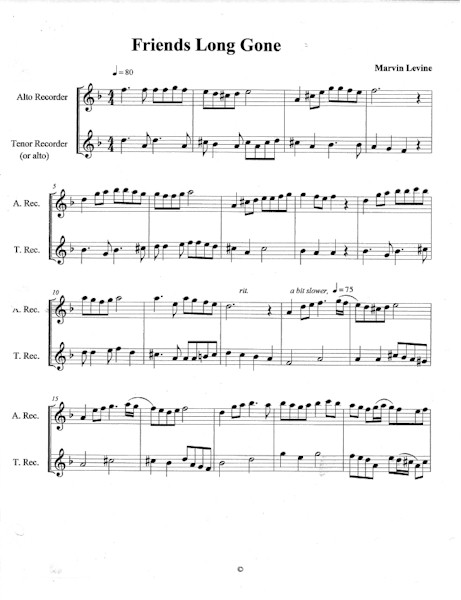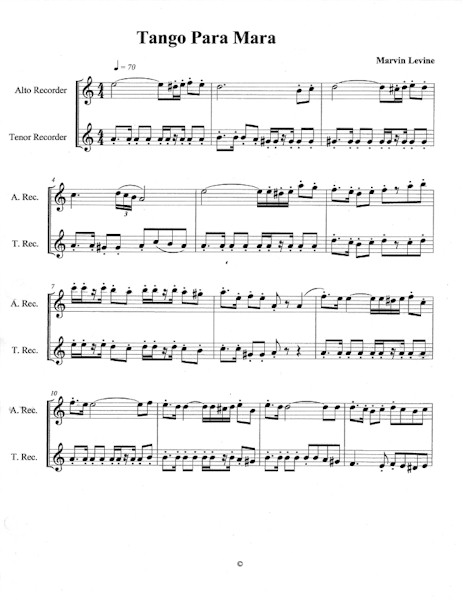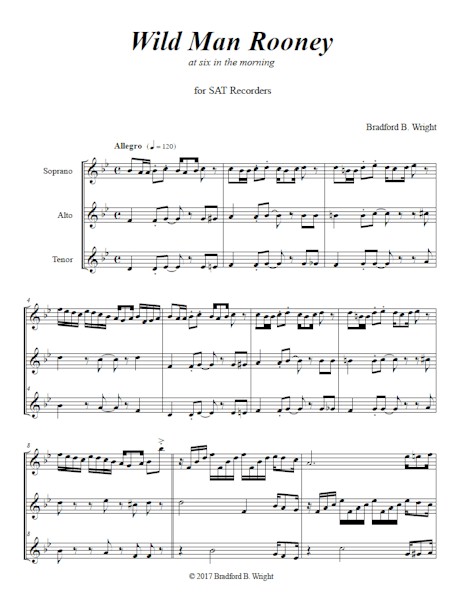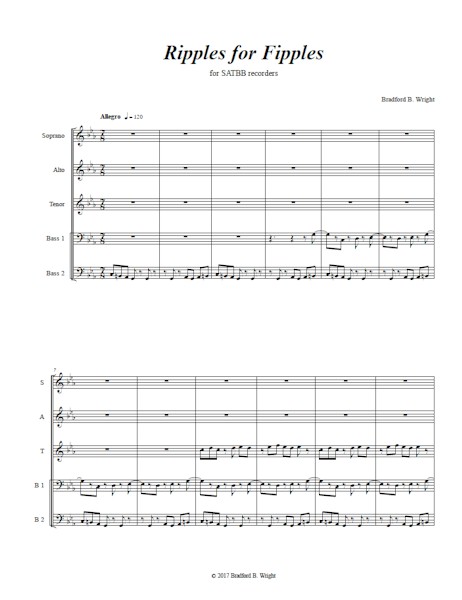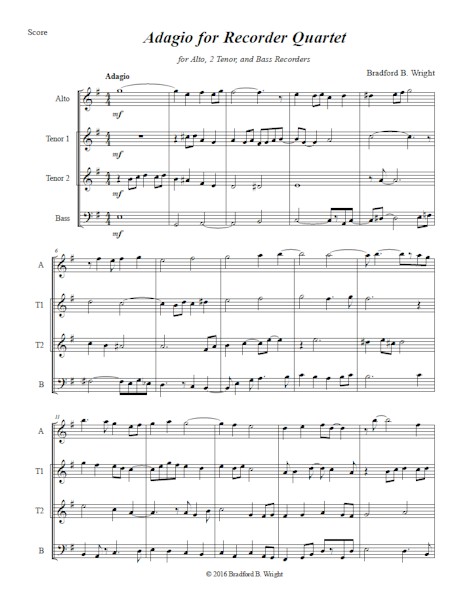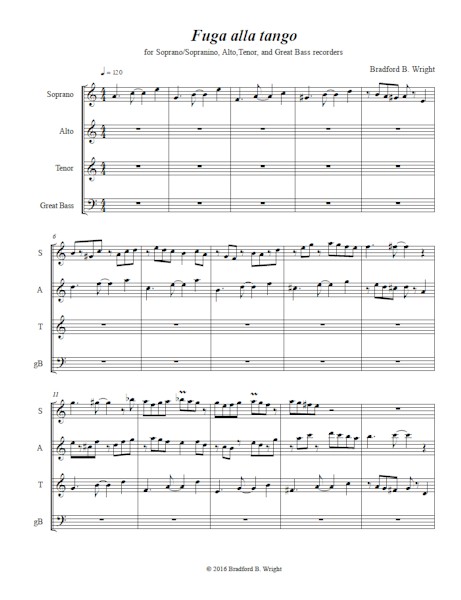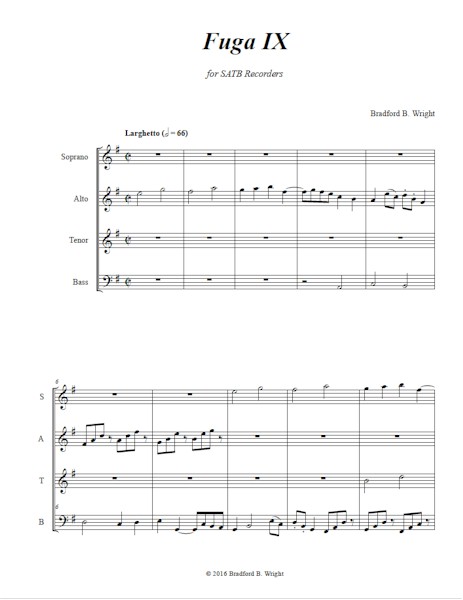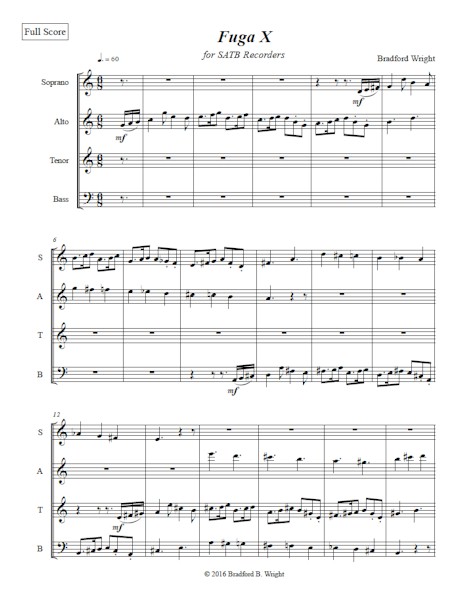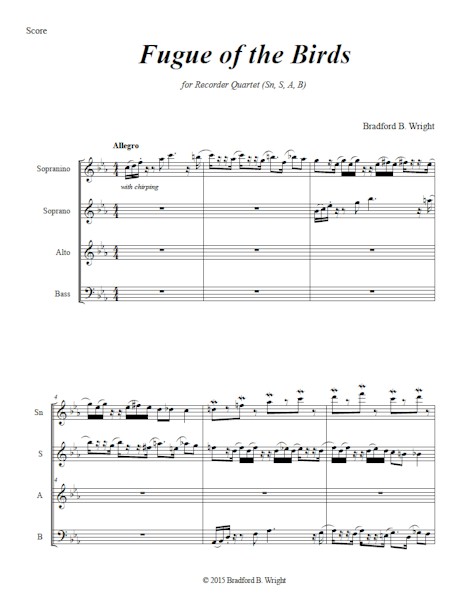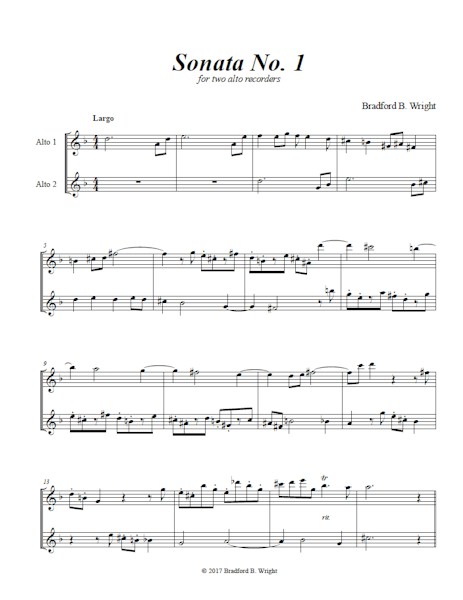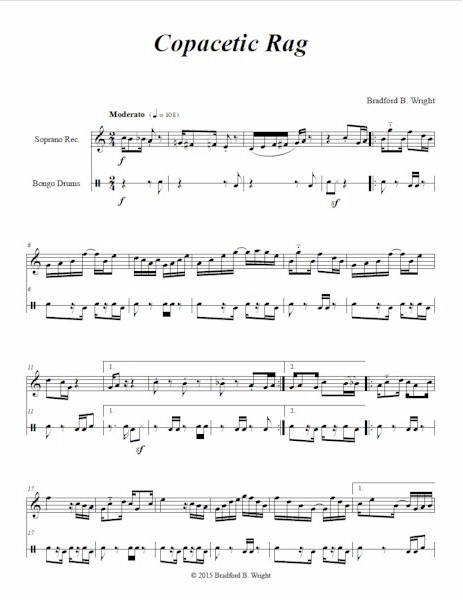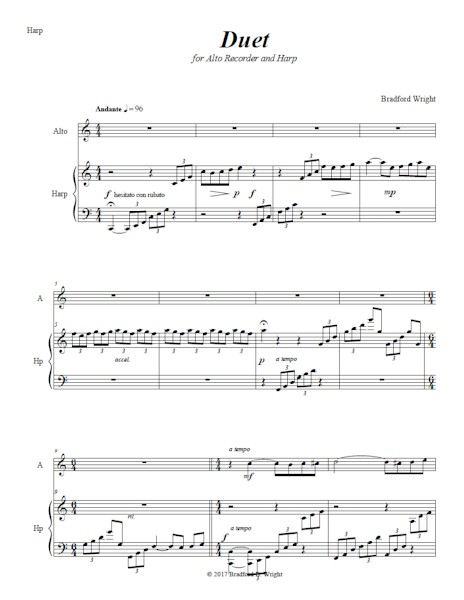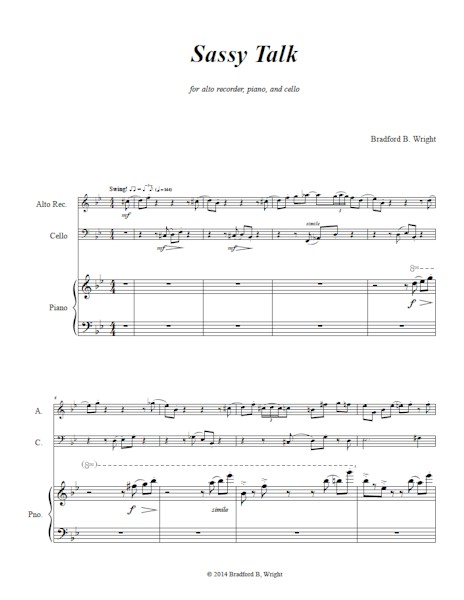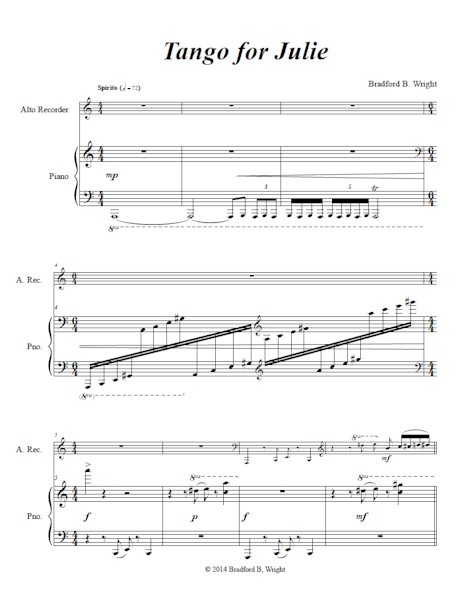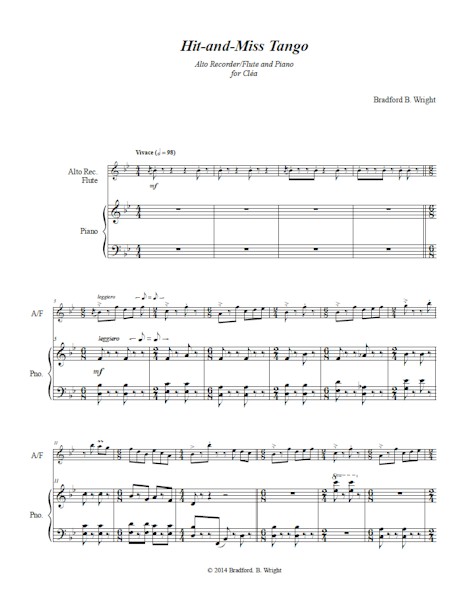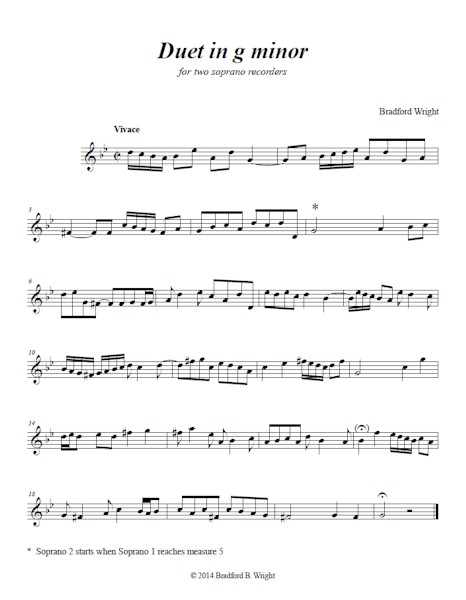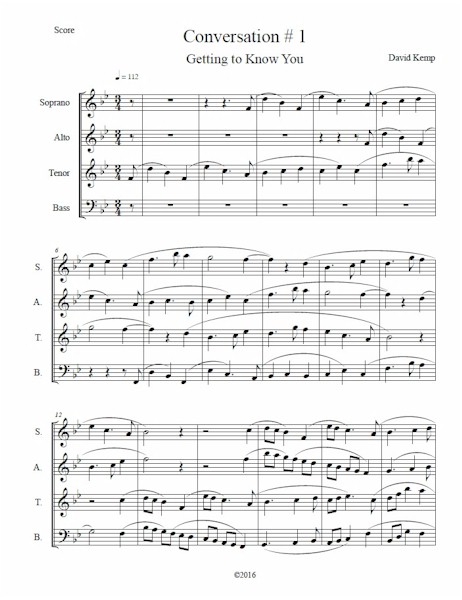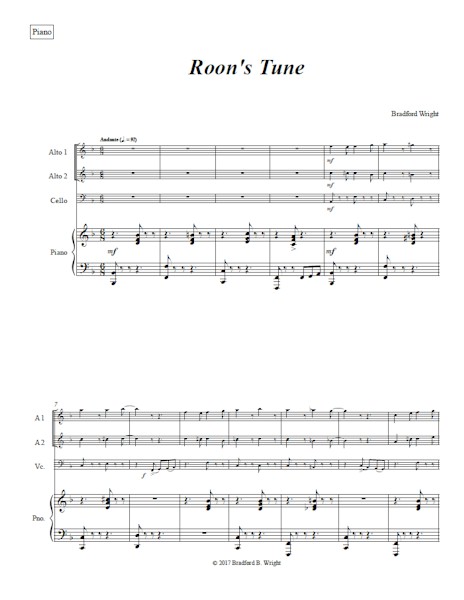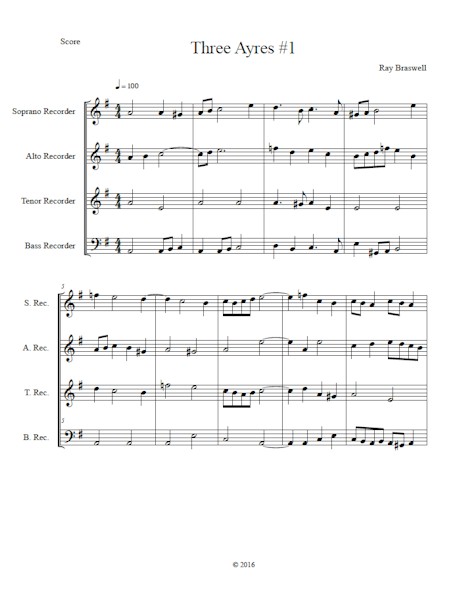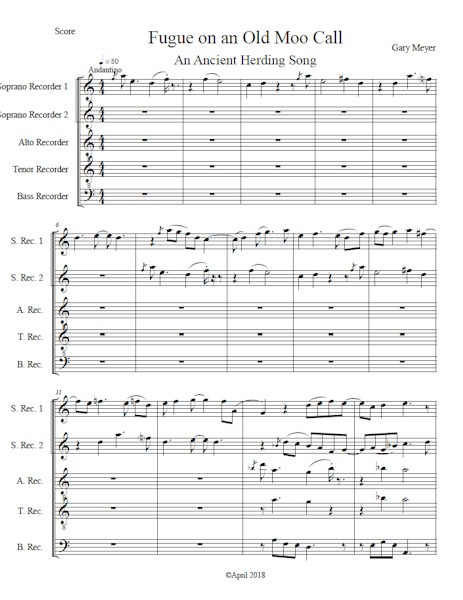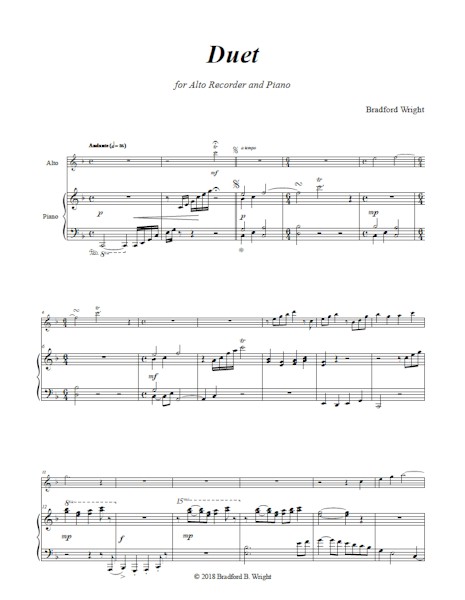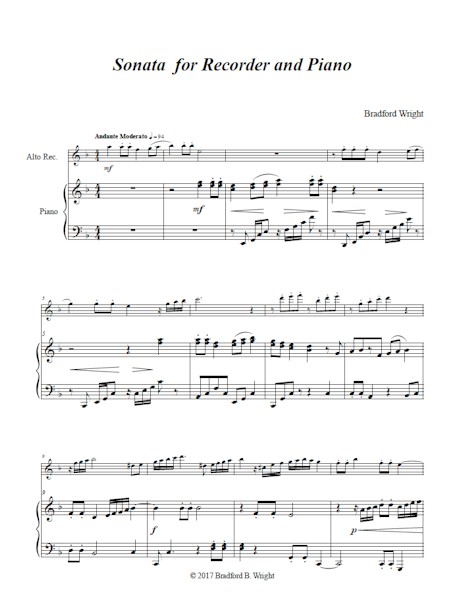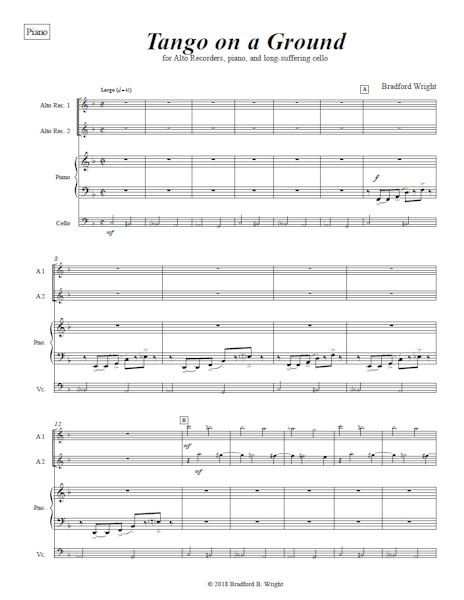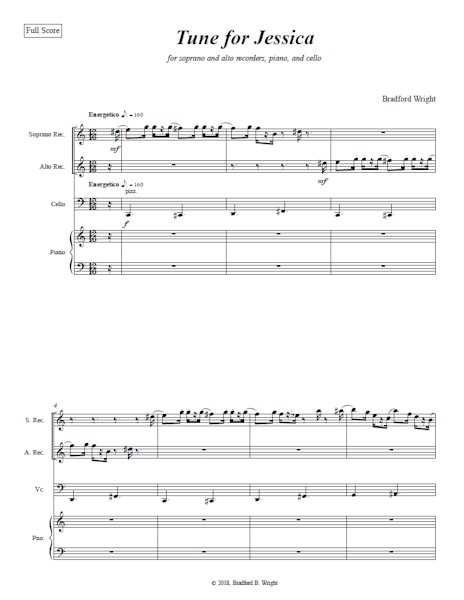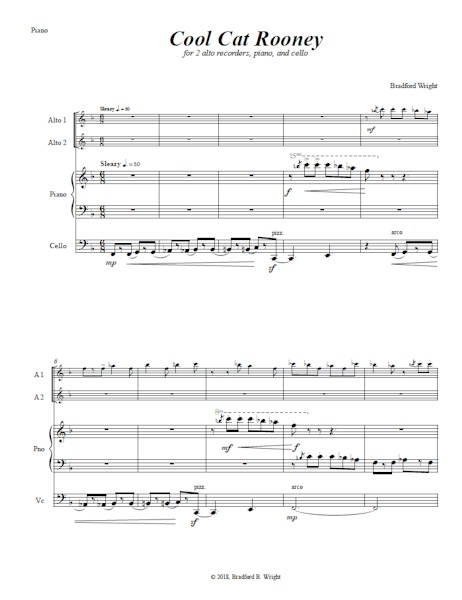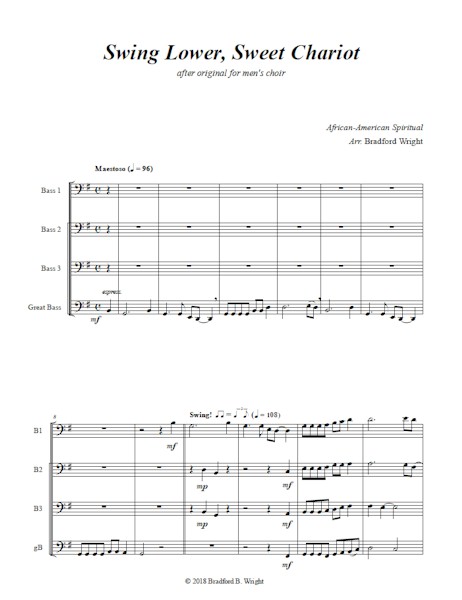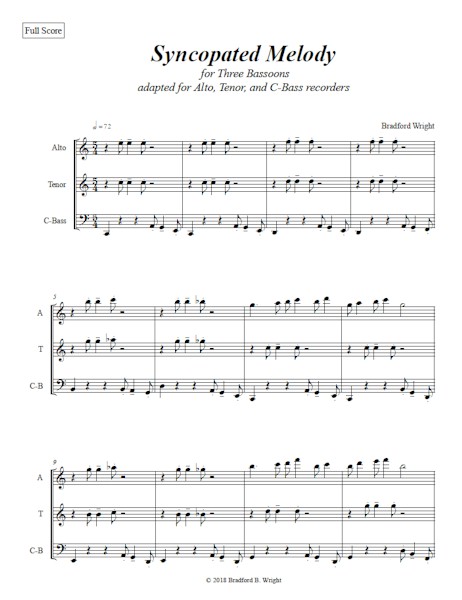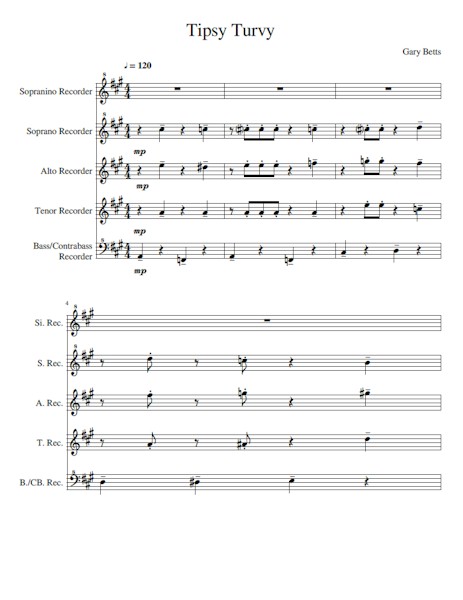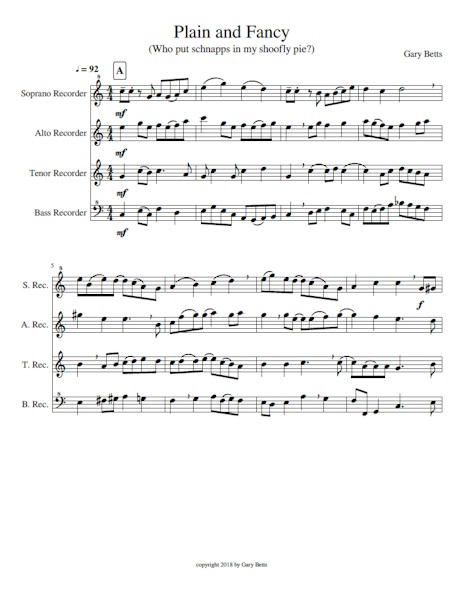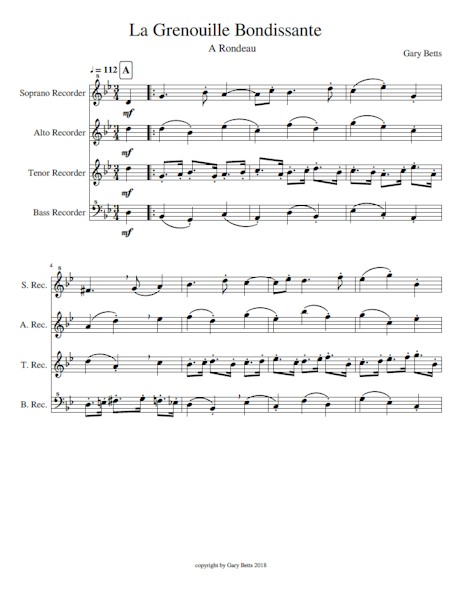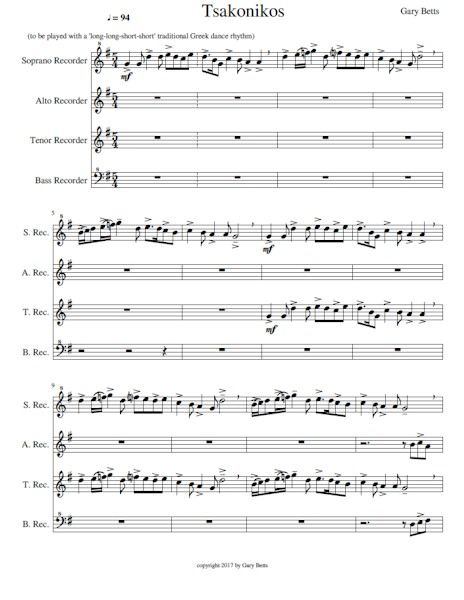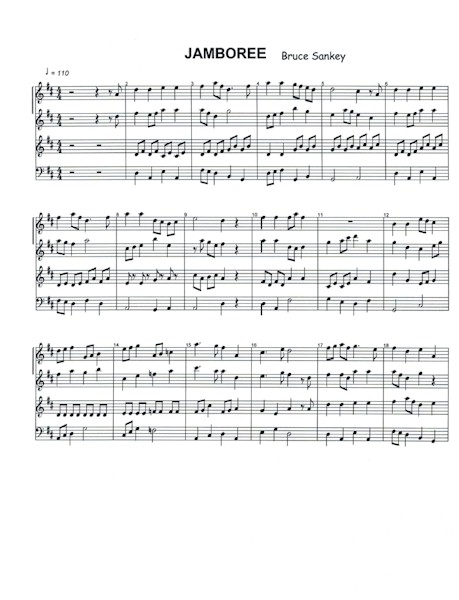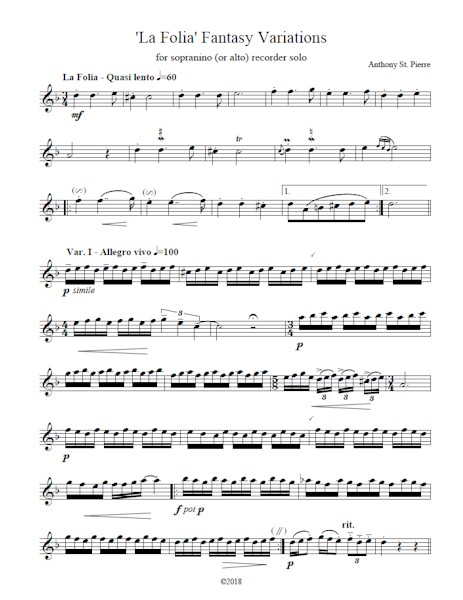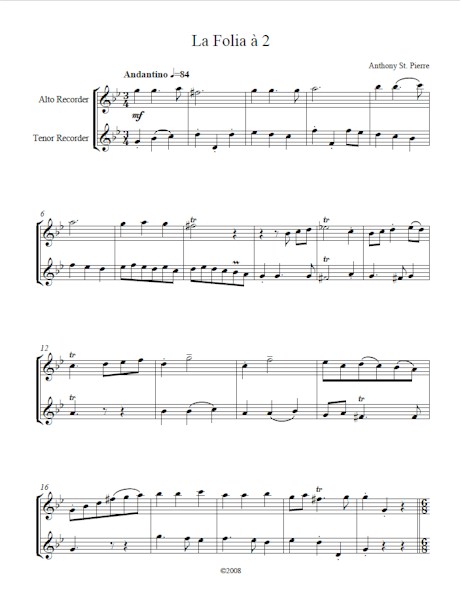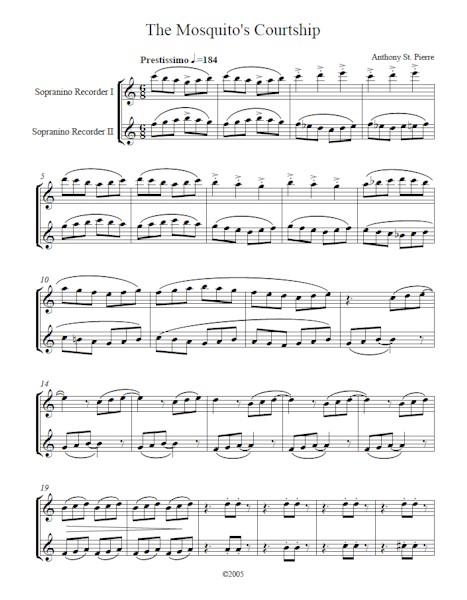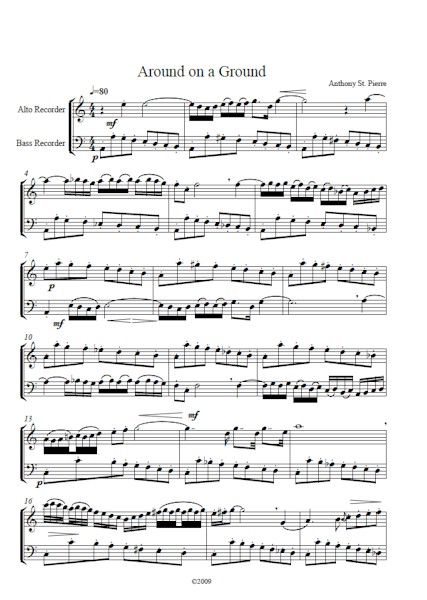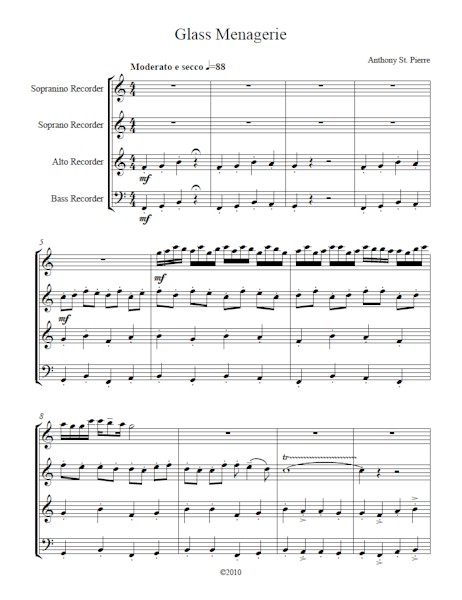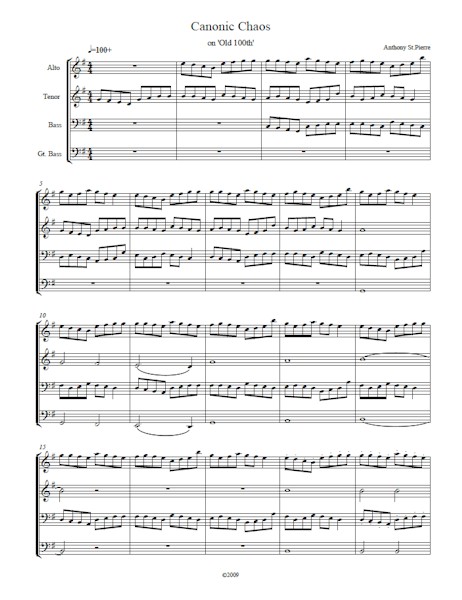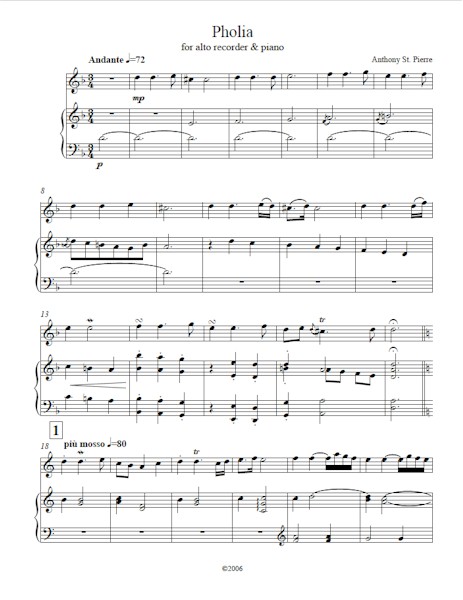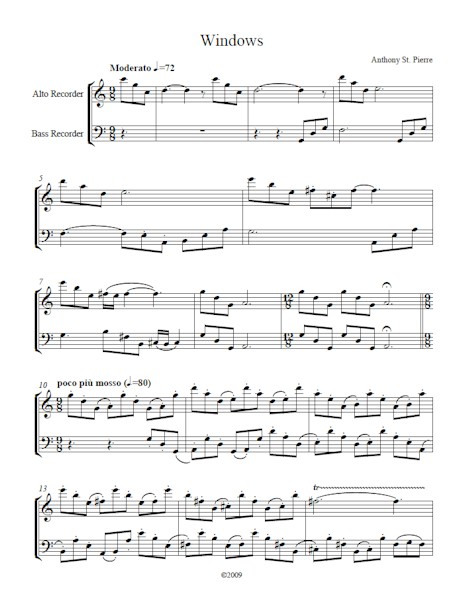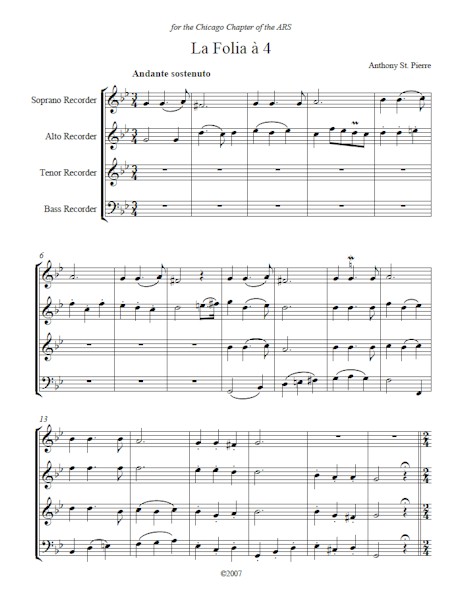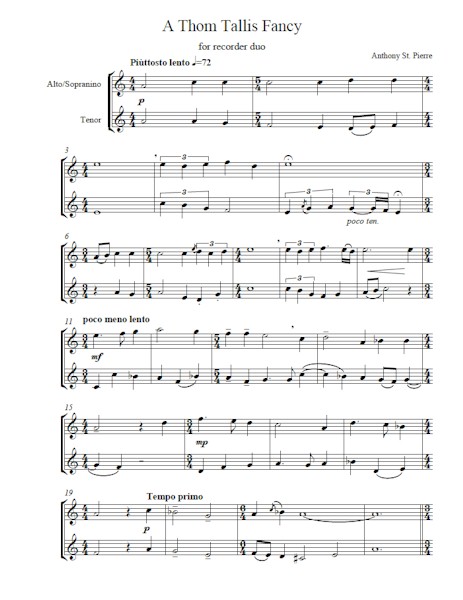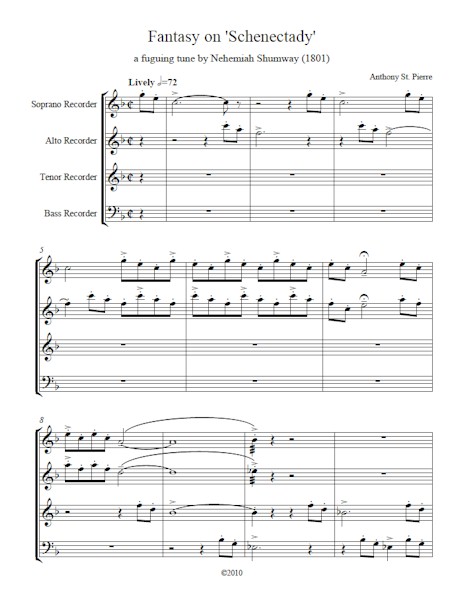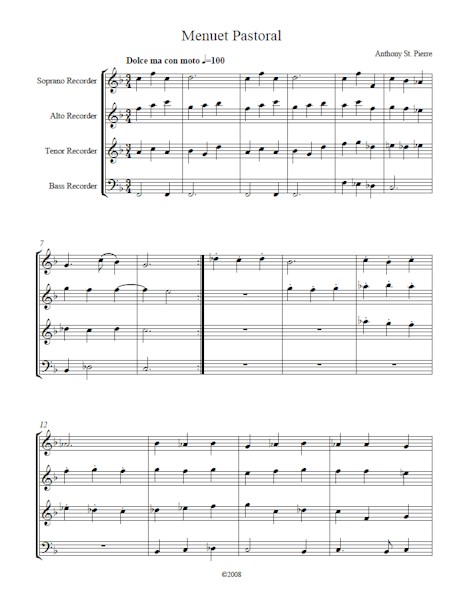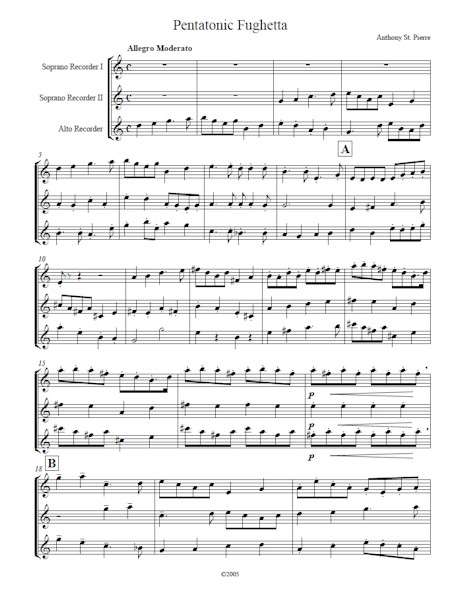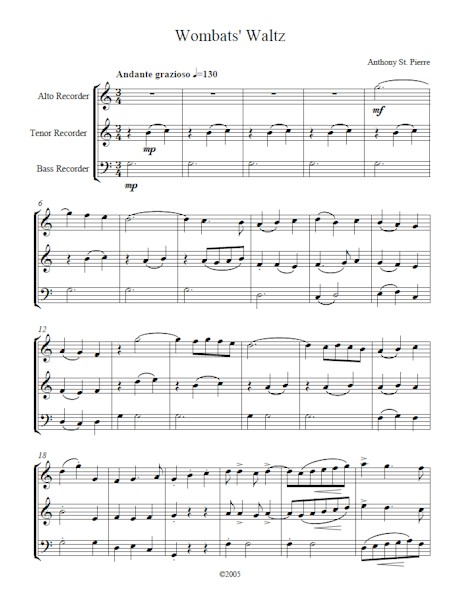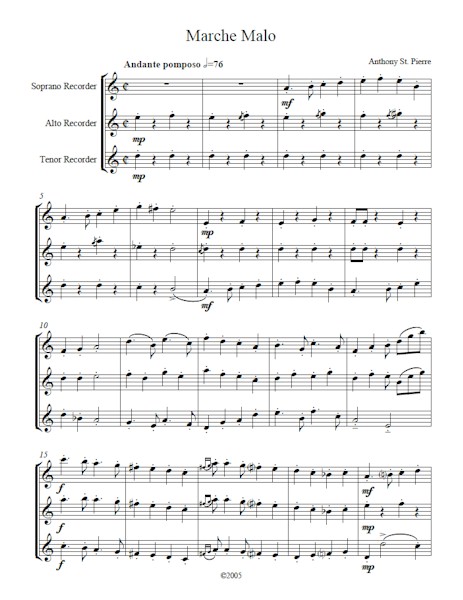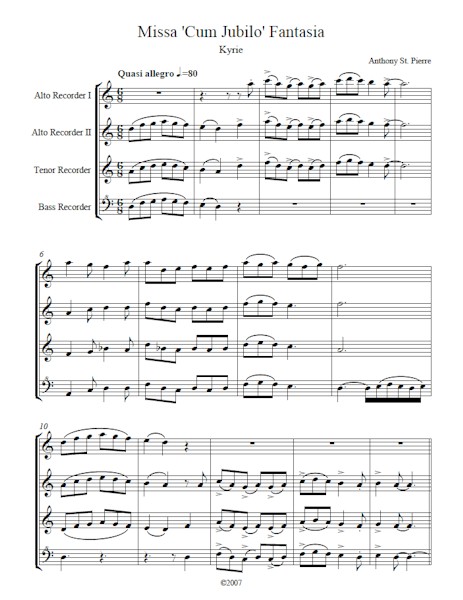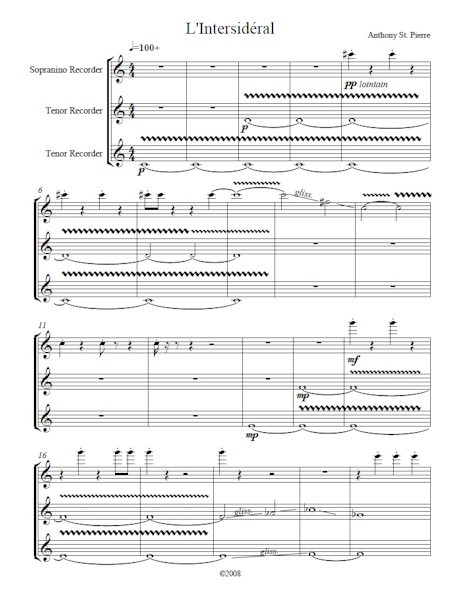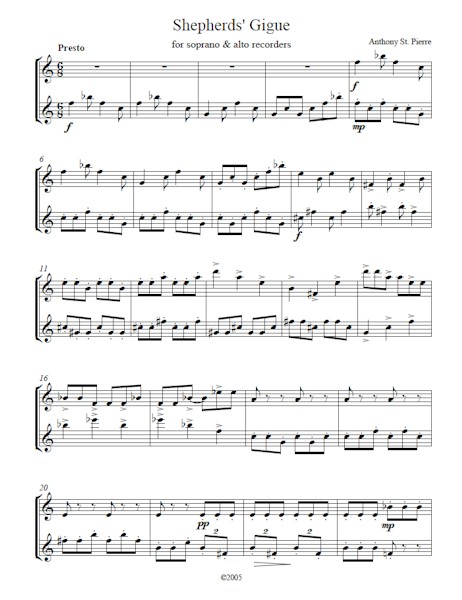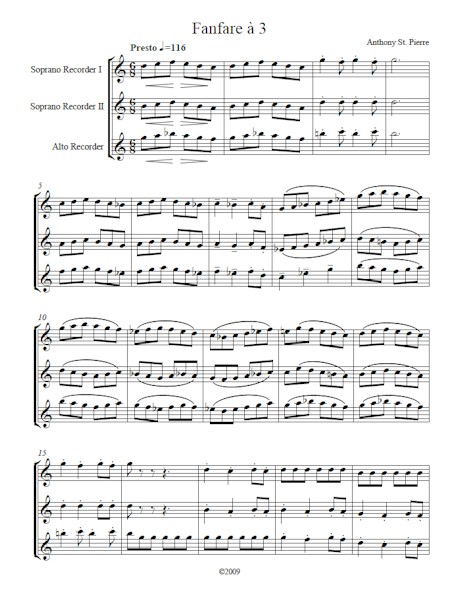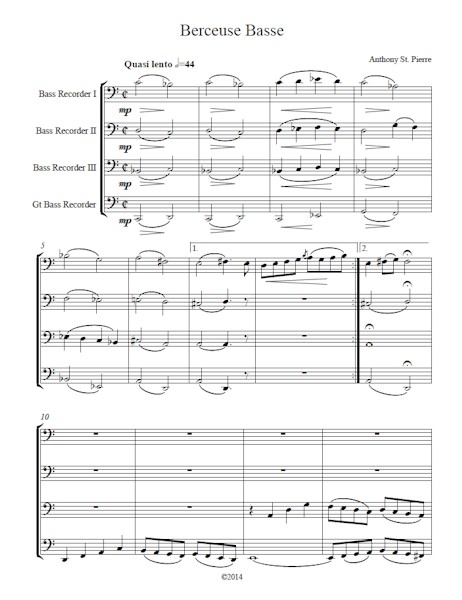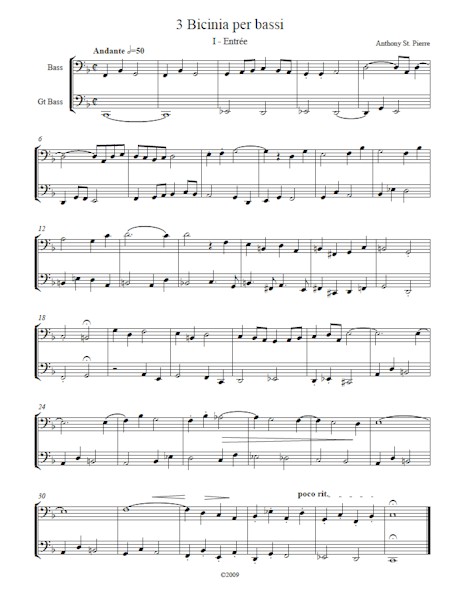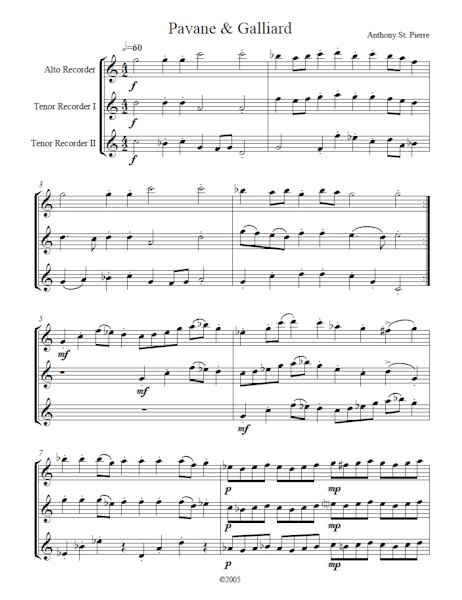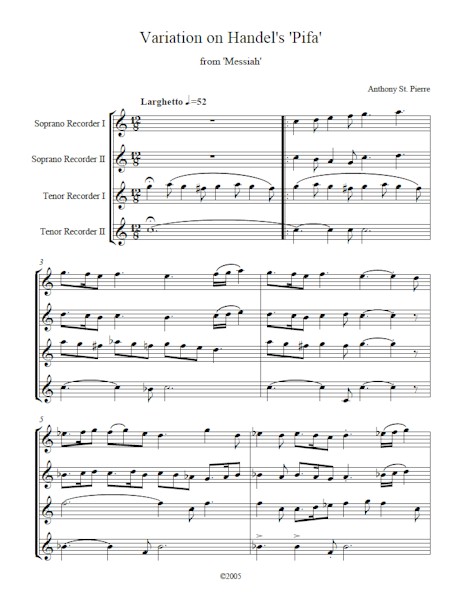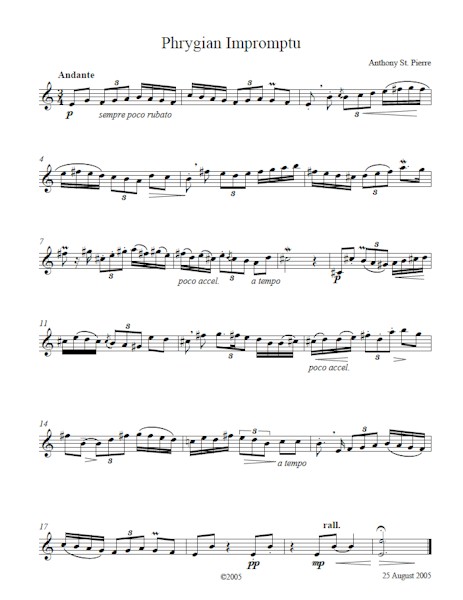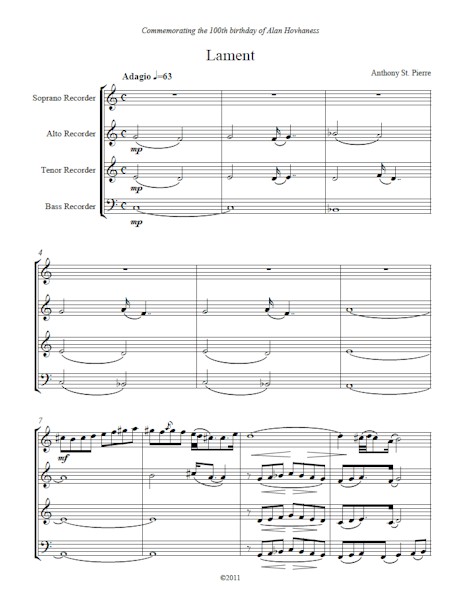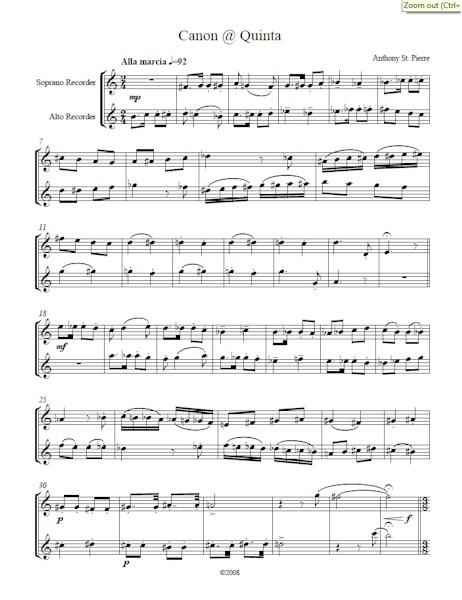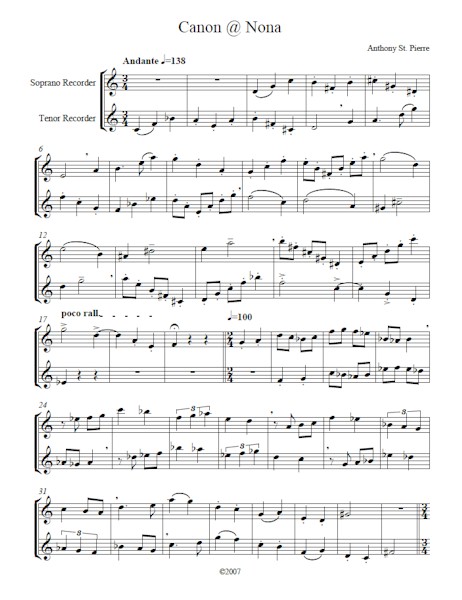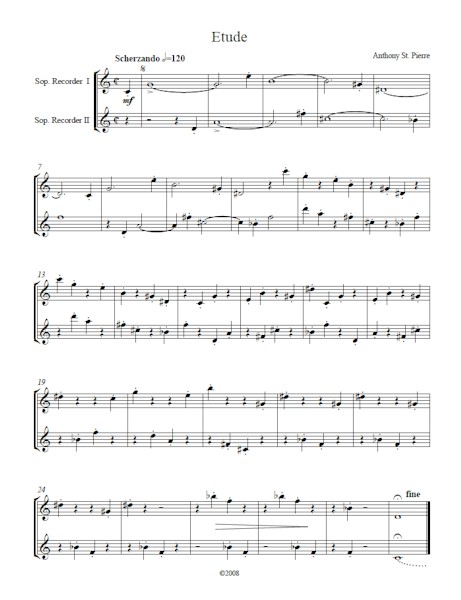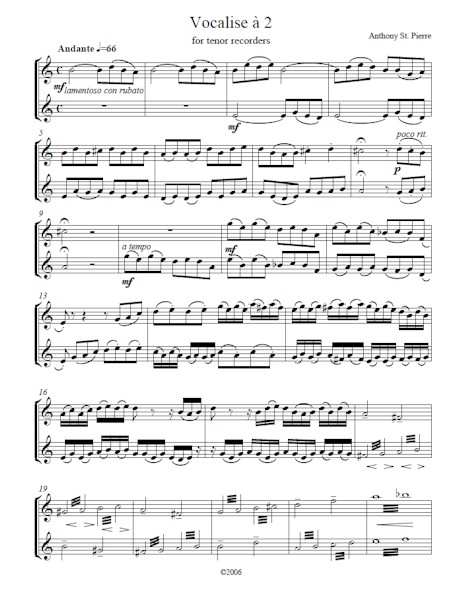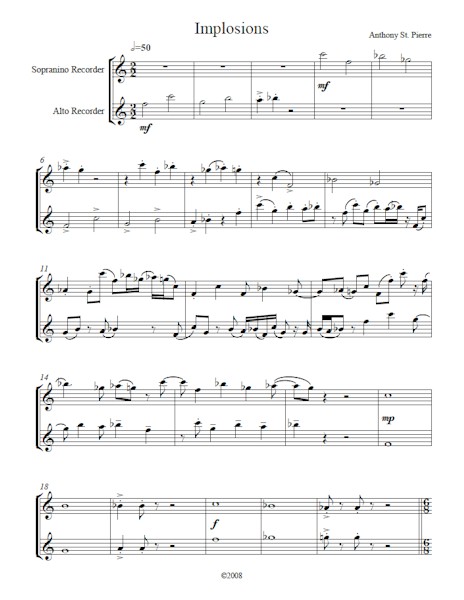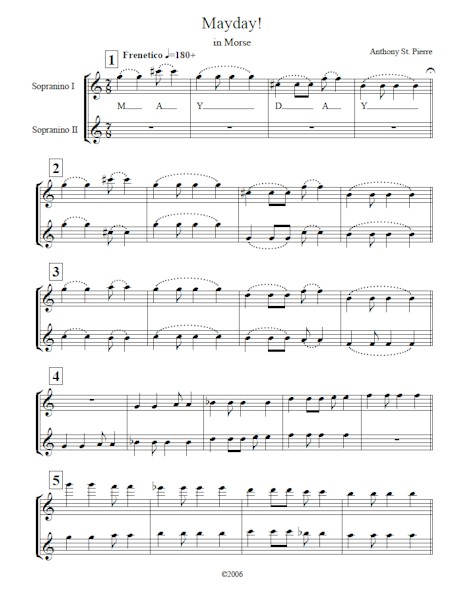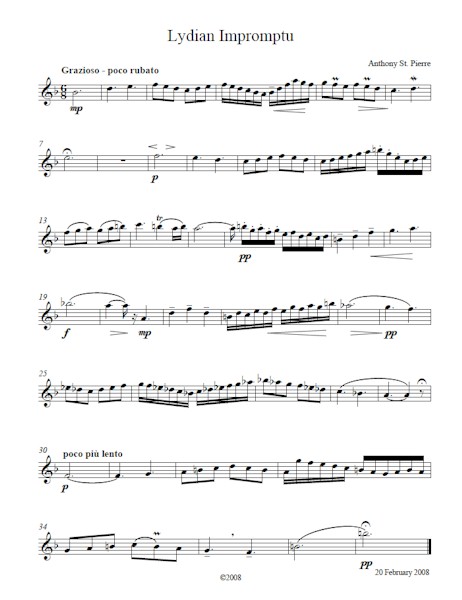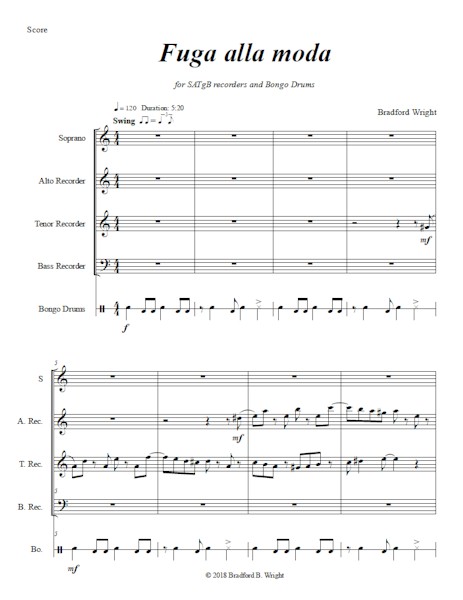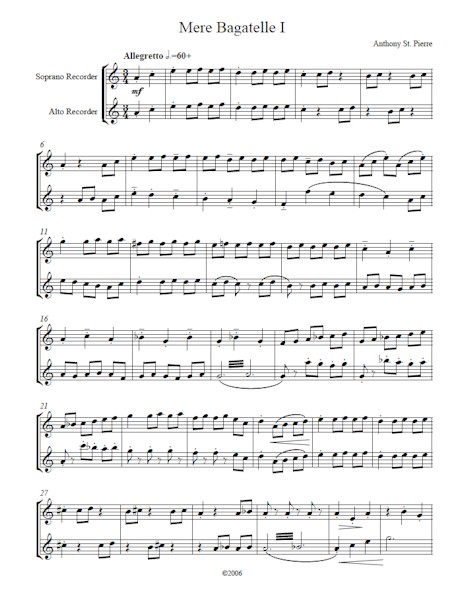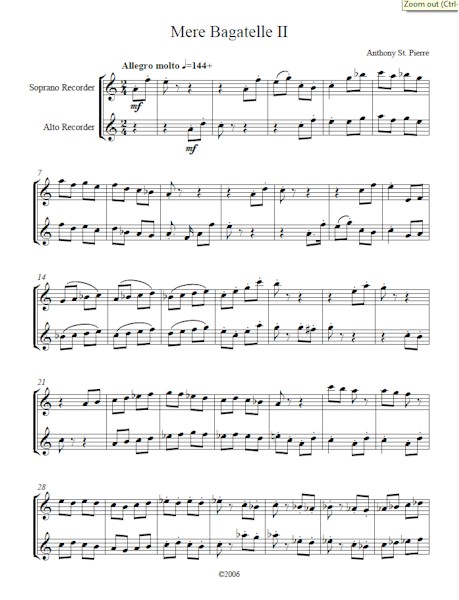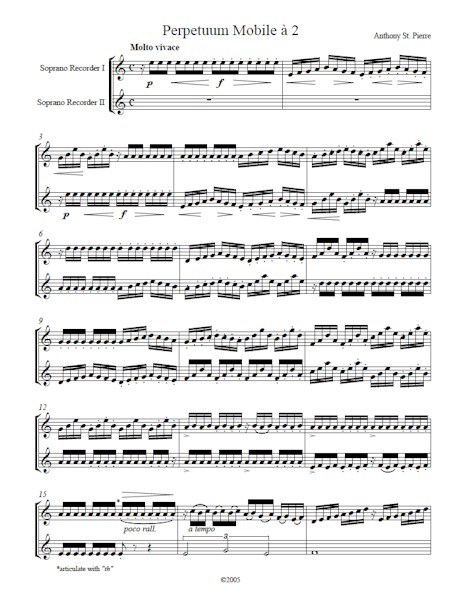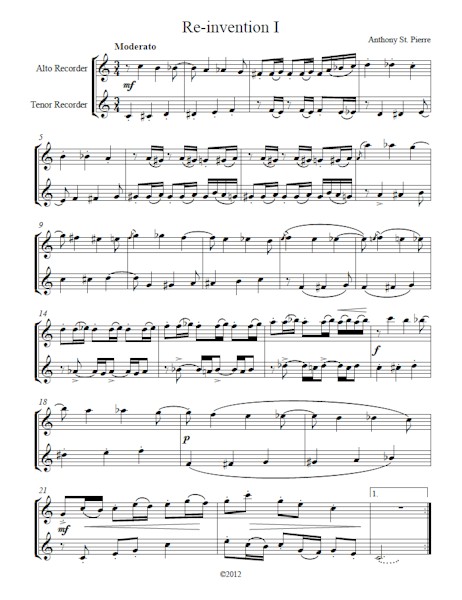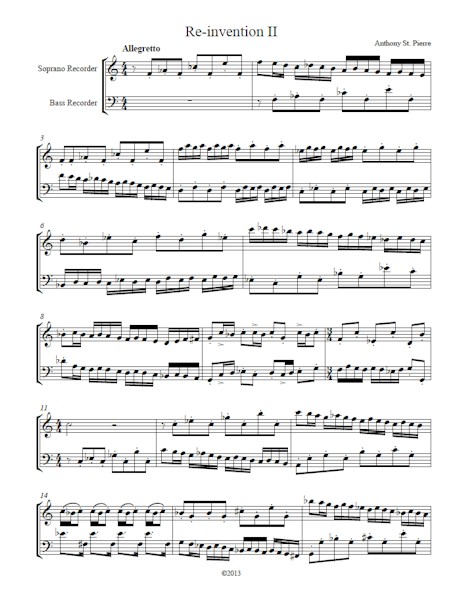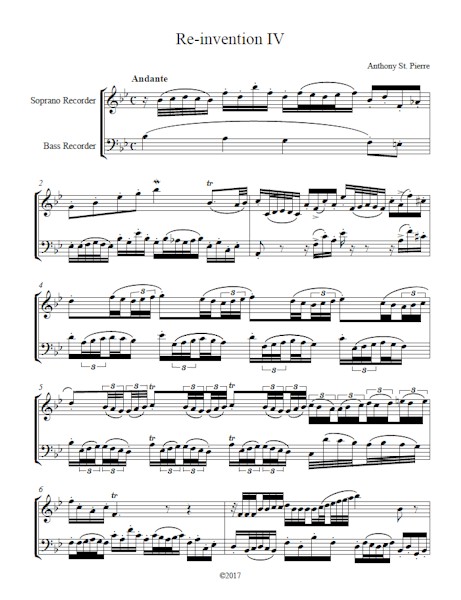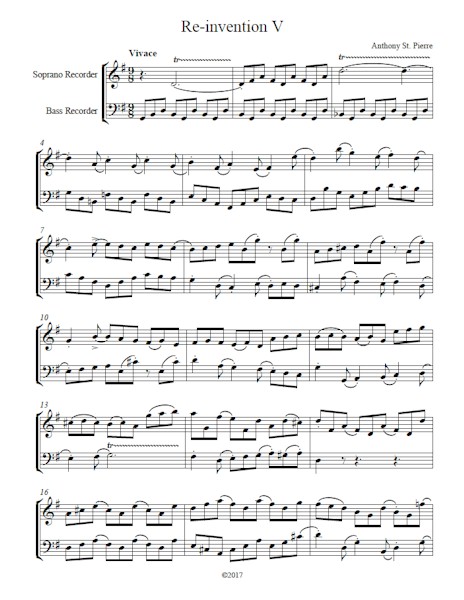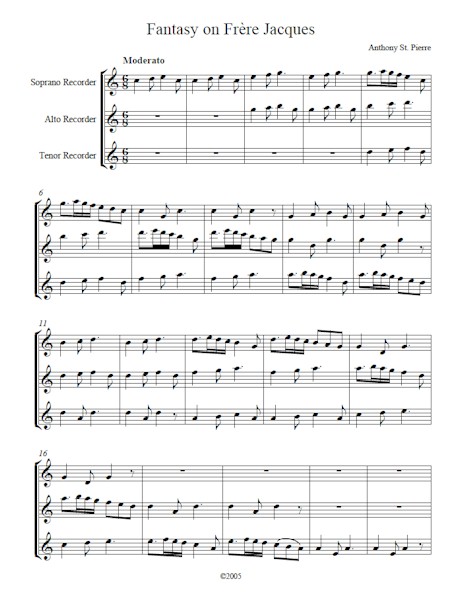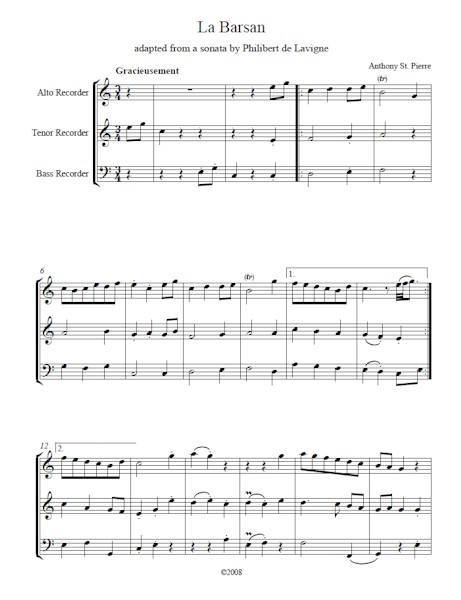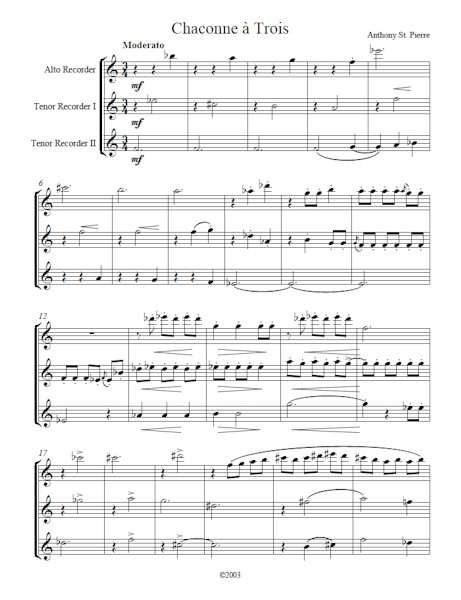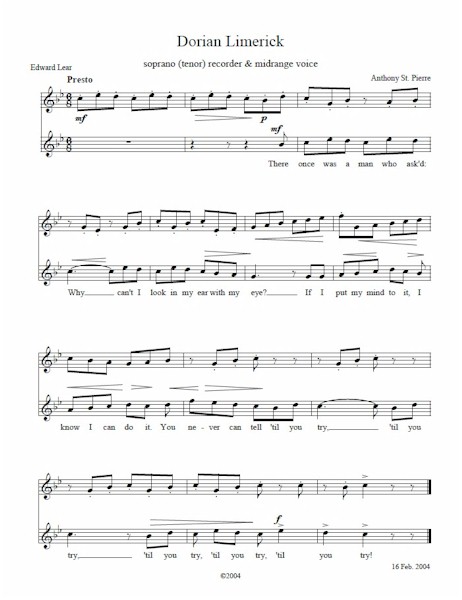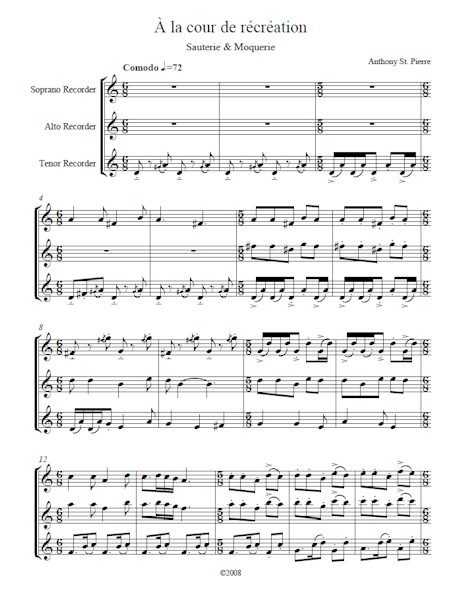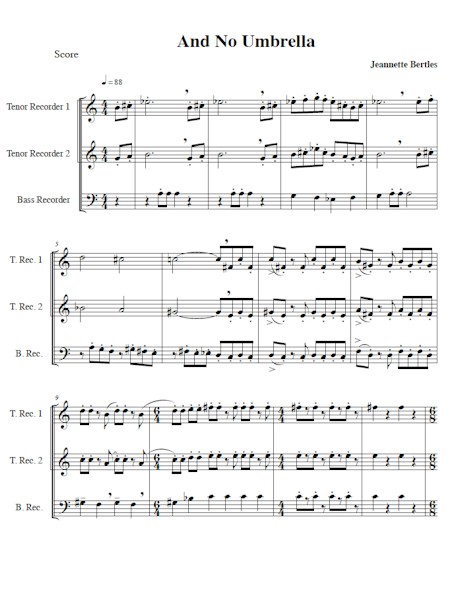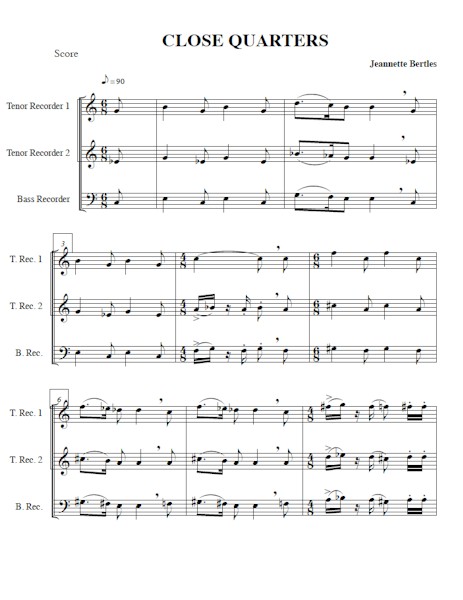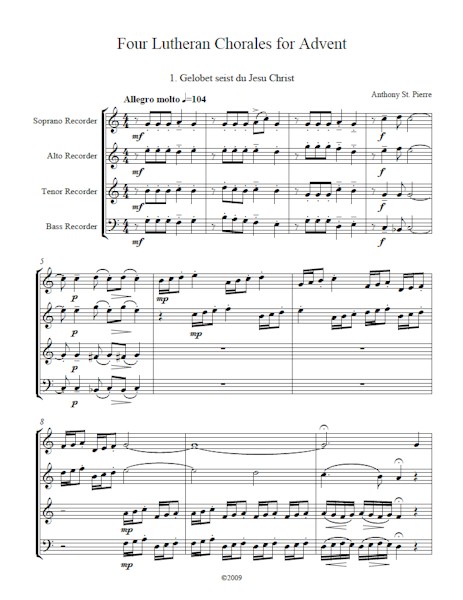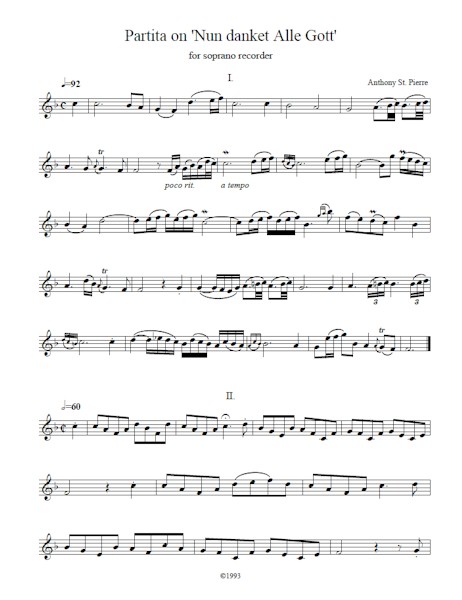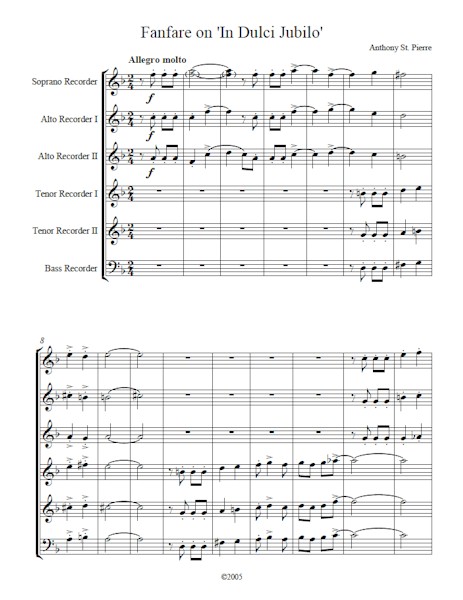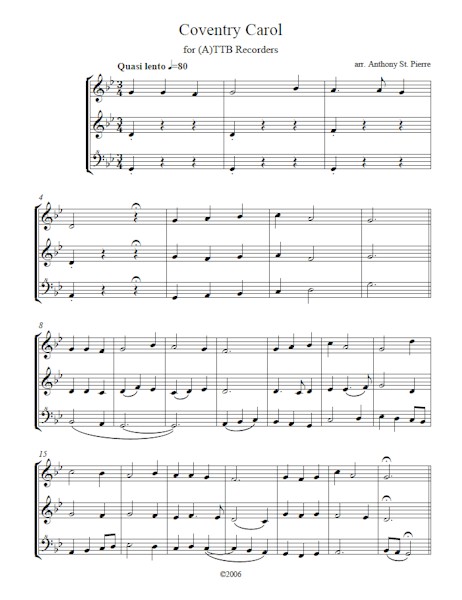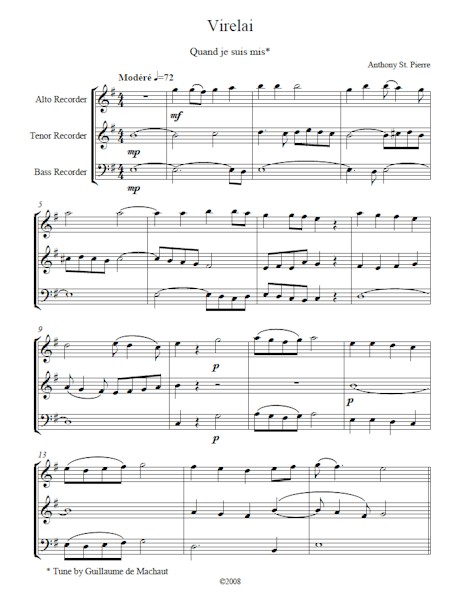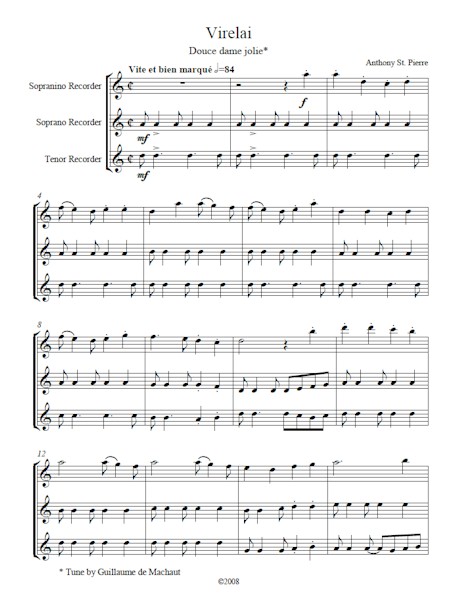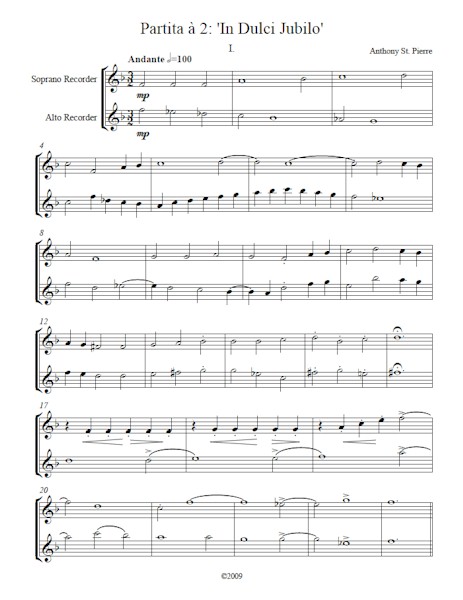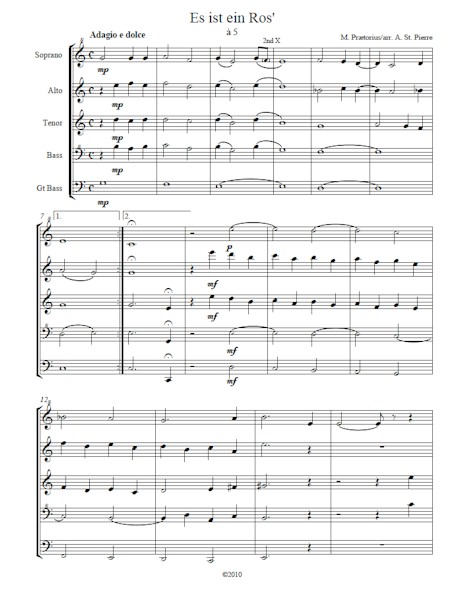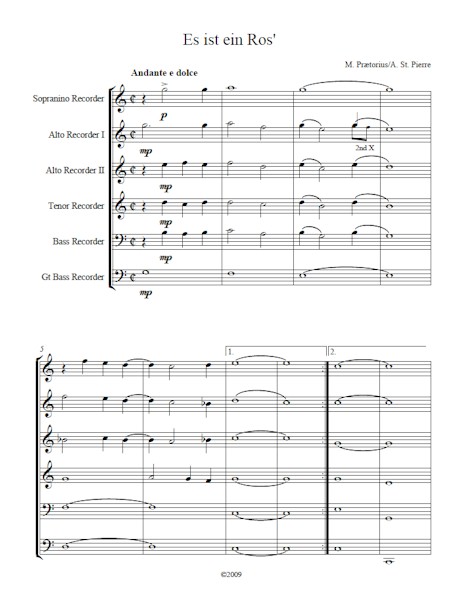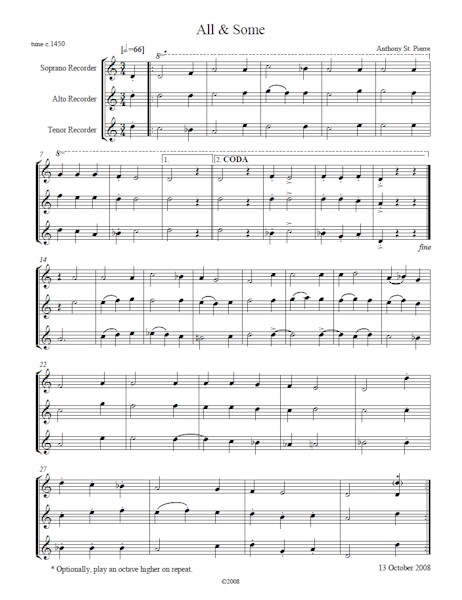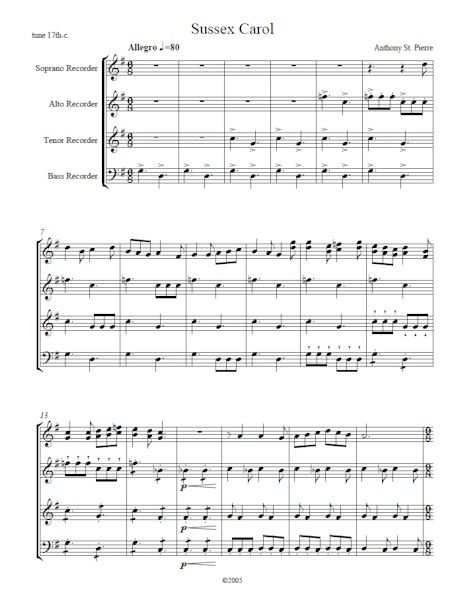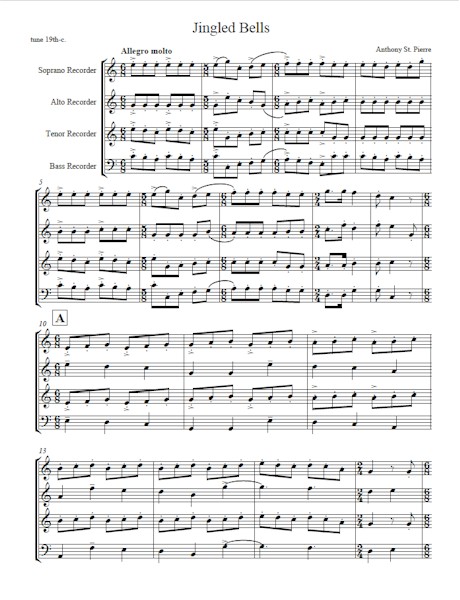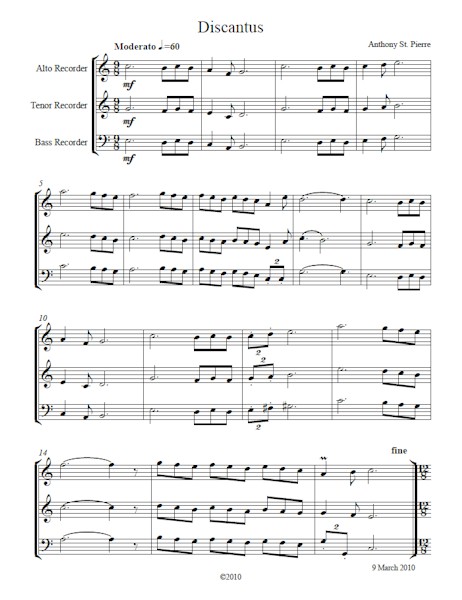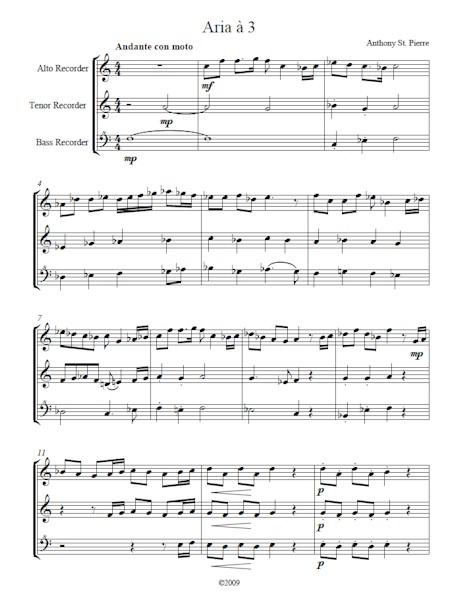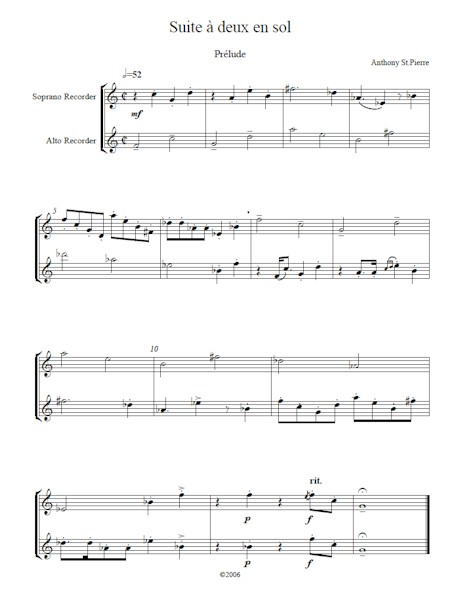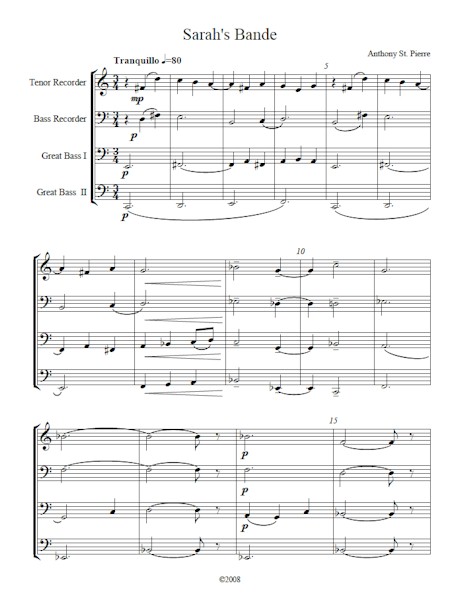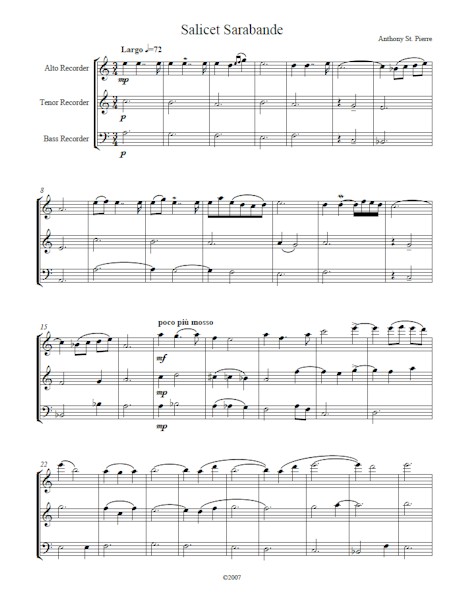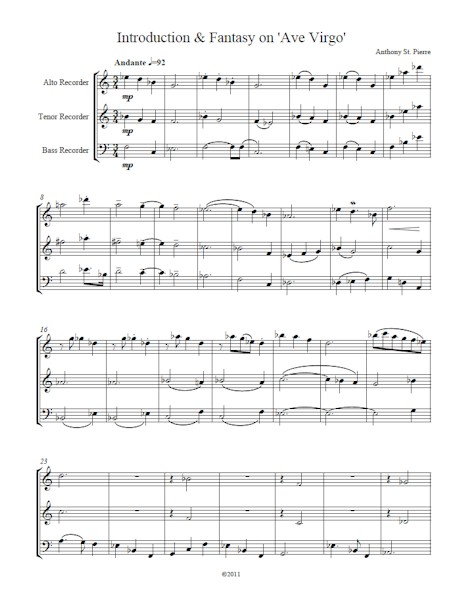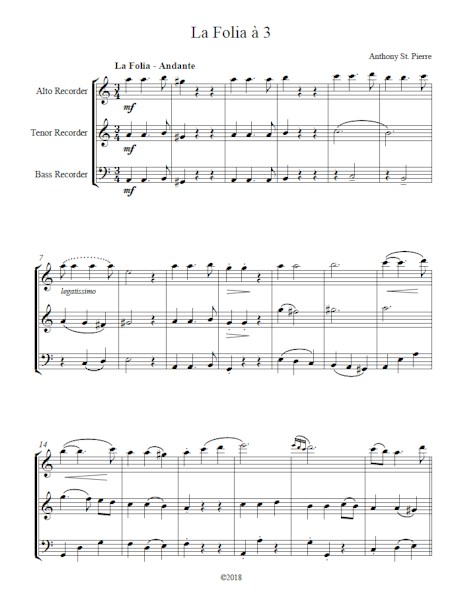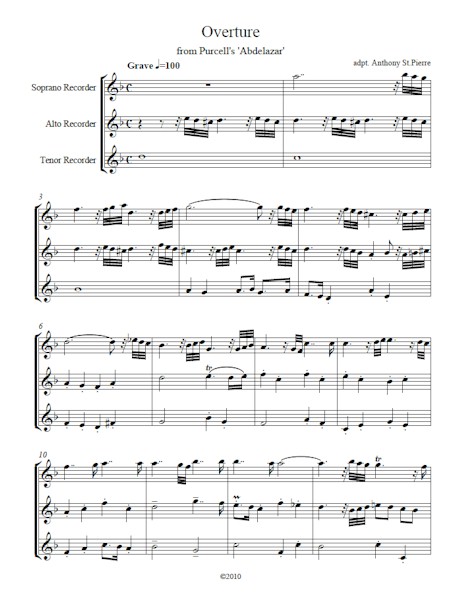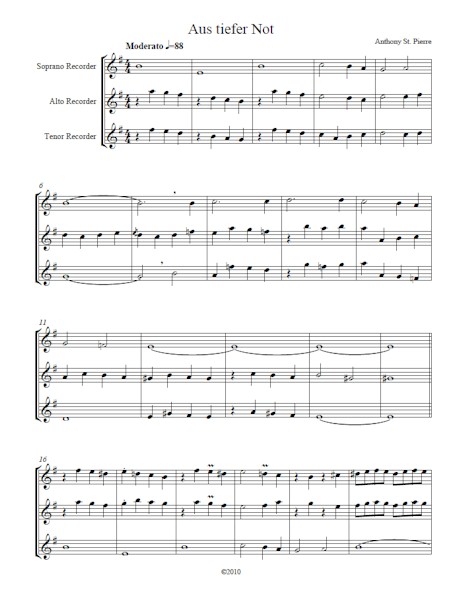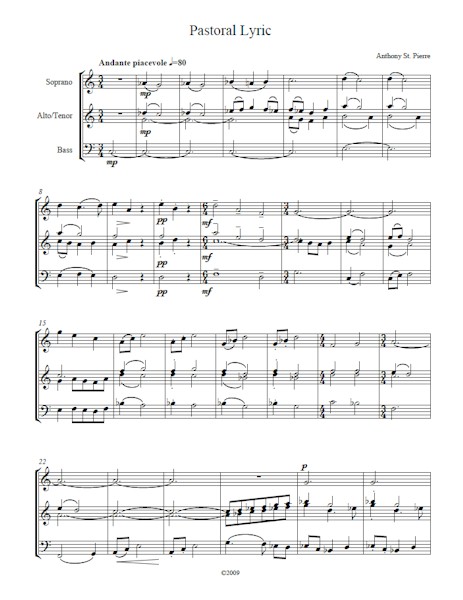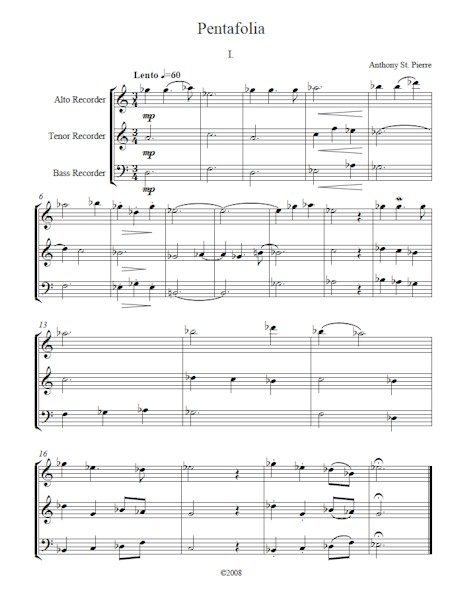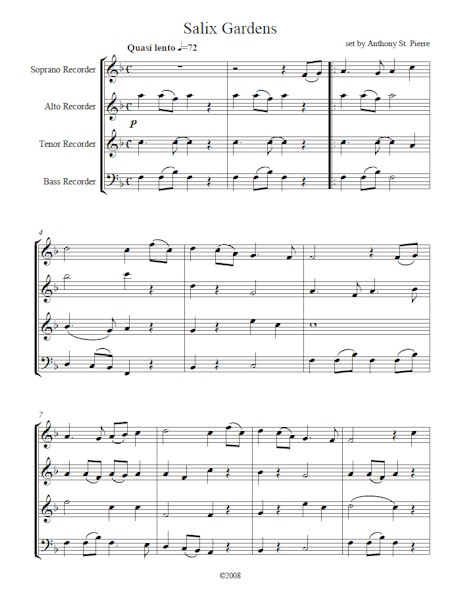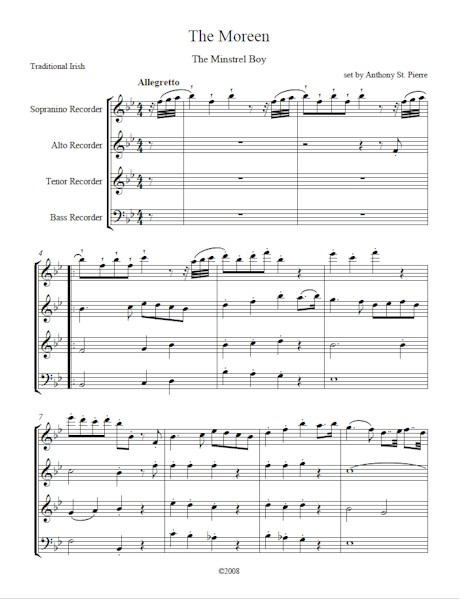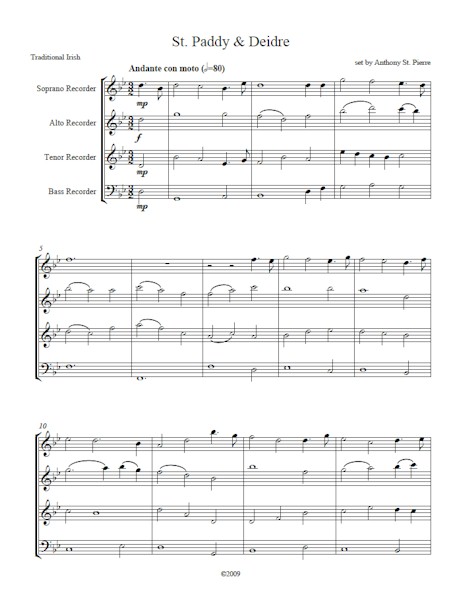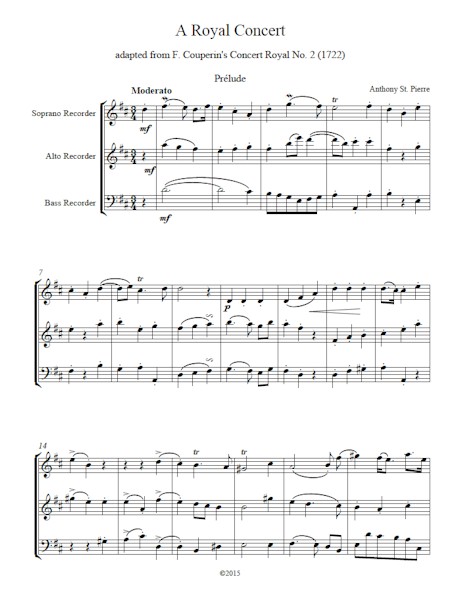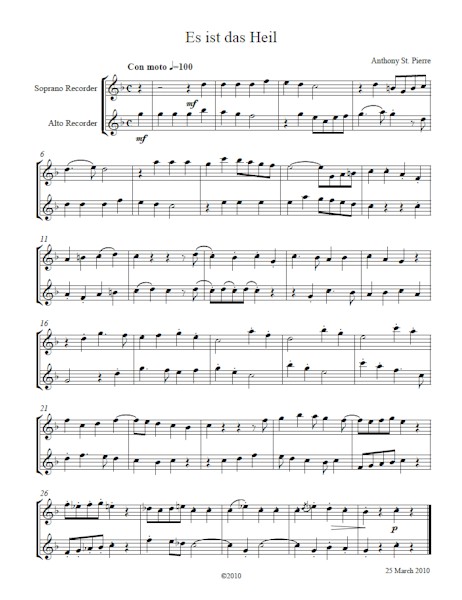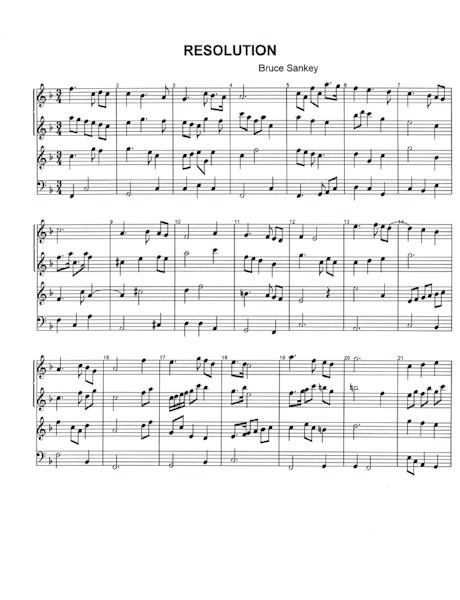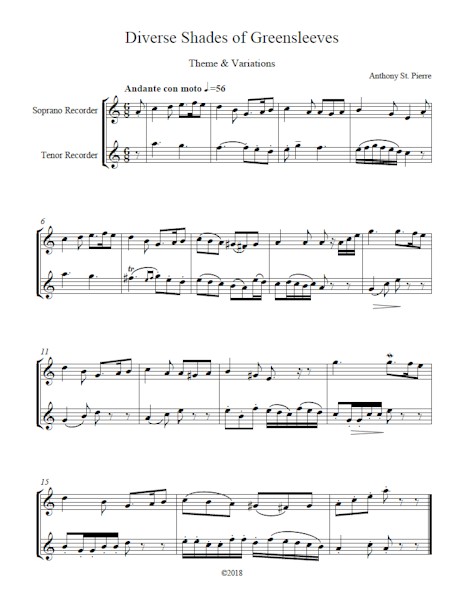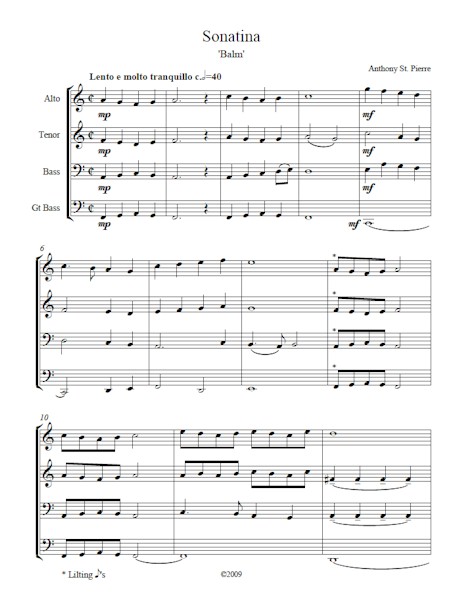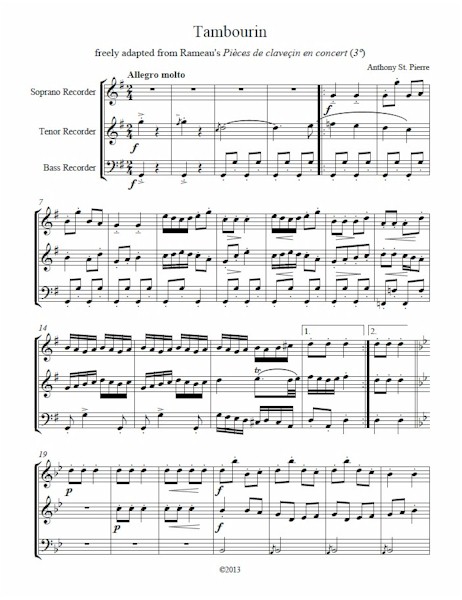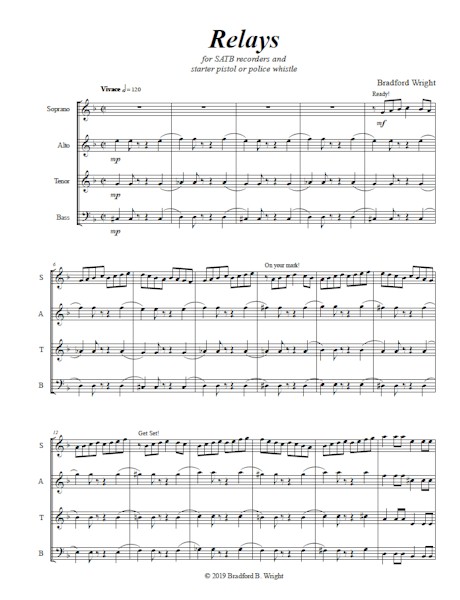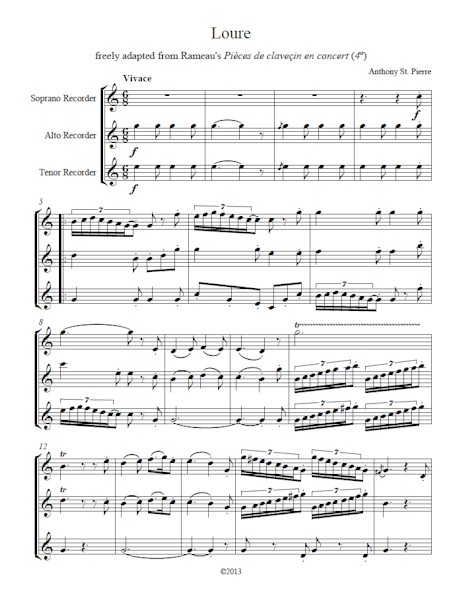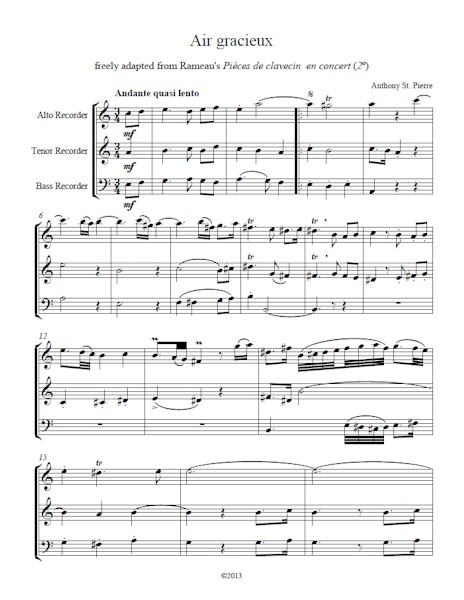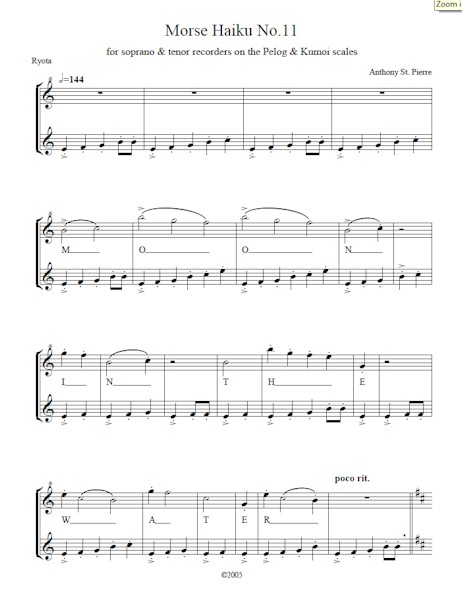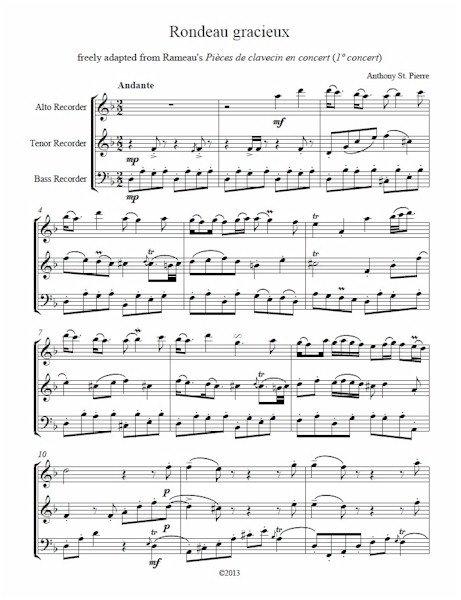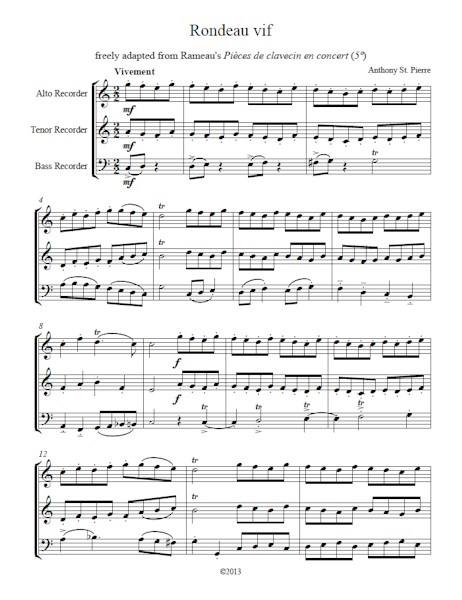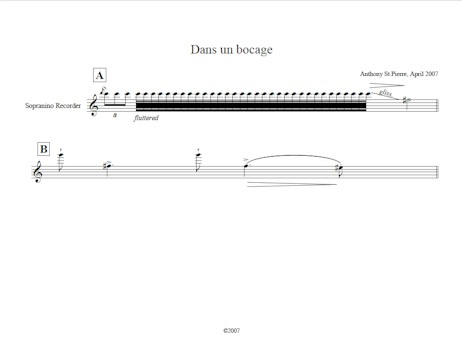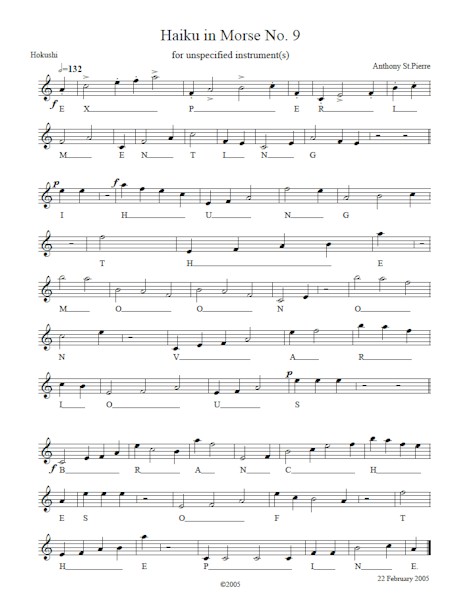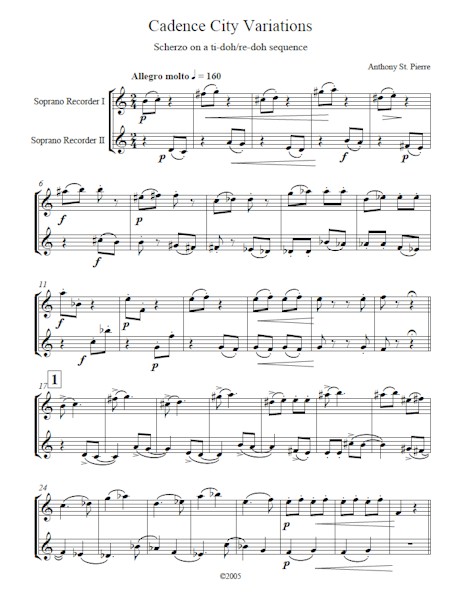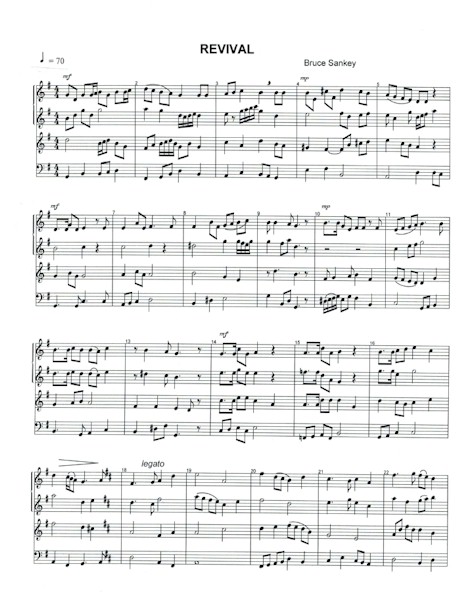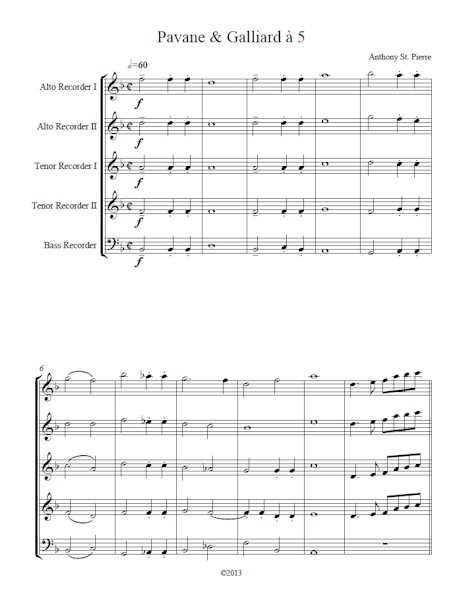Music - New Music for Recorder
Note: this page is no longer being updated as of May 2019. See our new searchable Music Libraries.The ARS is pleased to offer downloadable contemporary music written specifically for recorder players. These are original works for recorder (and potentially other instruments), not arrangements or transcriptions of previous works.
These composers’ submissions are available to logged-in ARS members by clicking on the provided links below. Non-members may view a preview and listen to a sound sample, if available. For information about joining ARS, click
HERE. Please note that the ARS does not specifically endorse nor commission any of the works provided on this page. We hope you enjoy playing and sharing these pieces!
Please observe any copyright limitations requested by the composer.If you are a composer interested in sharing your music for recorder on this website, please click here.NEWEST ADDITIONS: Anthony St. Pierre has contributed a recorded piano accompaniment for Song of a Siren, his composition for solo alto recorder and piano, and an organ accompaniment for Sonata da chiesa (2 soprano recorders and continuo). Click HERE for Song of a Siren, and HERE for Sonata da Chiesa, to play these "Music Minus One™" style! Also, scroll to the bottom of the page for more pieces by Anthony St. Pierre, including works for Lent and St. Patrick's Day, as well as new works by Bruce Sankey, "Resolution" and "Revival" (SATB), and Bradford Wright, "Relays," (SATB). Added January and February 2019 Sacramento Warm-up Fugue
by Glen Shannon, 2004
An easy 4-part fugue that I composed for the Sacramento Recorder Society when I was conducting them for the first time. It targets a slightly below the average ARS chapter's playing level but offers lots of interpretive and ornamentation possibilities.
Preview Sound Sample
Download
MP3 file
Times After Times
by Steven A. Jent, July 2016
Occasionally when I listen to unfamiliar music I'll hear a phrase and think I know what's coming next, and then I'm surprised when the composer does something different. Sometimes this prompts me to base a composition of my own on what I was expecting to hear but didn't. The first theme for this cheerful piece of swing was suggested by the brief ditty that plays when you complete a crossword puzzle on the New York Times website.
Preview Sound Sample
Download
MP3 file
145 Ways To Go
by Michael Shonle, Oct. 14, 2013
This piece is a simple solo featuring a repeating theme and a set of variations. Each pattern is 8 bars long, and show the many ways that the simple 1 bar sequence can lead to.
Preview Sound Sample
Download
MP3 file
Autumn in the Air
by Marvin Levine (1928 - 2016)
This is a delightfully melancholy duet for two Altos that's full of imagery of the shortening days and cooling weather. Easily accessible to lower intermediate players and up.
Preview Sound Sample
Download
MP3 file
Friends Long Gone
by Marvin Levine (1928 - 2016)
A quasi-Klezmer piece suitable for intermediate and up, this duet for two Altos or AT has rich wide intervals (C#-Bb) and multiple moods. Beautiful haunting melodies and equal distribution of material between the parts make this a piece to have a good cry over with a friend who's still with us.
Preview Sound Sample
Download
MP3 file
Tango Para Mara
by Marvin Levine (1928 - 2016)
Written for his wife Mara, this duet for AT is suitable for upper intermediate players with fun syncopations and delicious tango feel.
Preview Sound Sample
Download
MP3 file
Fuga alla Tango
by Bradford Wright, November 2016
Quartet for Soprano (switches to Sopranino), Alto, Tenor, and Great bass. Individual parts are not too hard, but ensemble can be tricky during the really fun overlapping syncopations. Upper intermediate to advanced level.
Preview Sound Sample
Download
MP3 file
Conversation #1
by David E. Kemp, 2017
This is an exploration of a fugue subject that I remembered from a waking dream. (No, I don't listen to the radio as an alarm.) The theme starts as a four voice canon and then develops in various ways until the final chorale.
Parts are available from www.recordermusic.us upon request.
Preview Sound Sample
Download
MP3 file
Highland Concerto
by John Franek, completed January 2017
The Highland Concerto is a neo-baroque concerto grosso commissioned by the Highland Park Recorder Society for their "Hits and Highlights of 7 Centuries" concert, which celebrated the group's 30th anniversary. The piece was premiered on the 18th of March, 2017 in the United Methodist Church of New Brunswick, New Jersey.
Detailed throughout the progression of the piece is a dialogue between the harmonic worlds of the Baroque and Modern eras. These two worlds eventually form a cohesive whole in the final movement, finally resolving the intrinsic search for identity which follows the piece. The fourth movement also contains an extended harpsichord solo-cadenza, directly inspired by the iconic harpsichord solo in the first movement of Bach's Brandenburg Concerto No. 5.
Preview I Prelude Sound Sample
II Allegro Sound Sample
III Adagio Sound Sample
IV Canon Sound Sample
V Allegro Sound Sample
Download Score and all parts
Download Conductor's Score
MP3 file
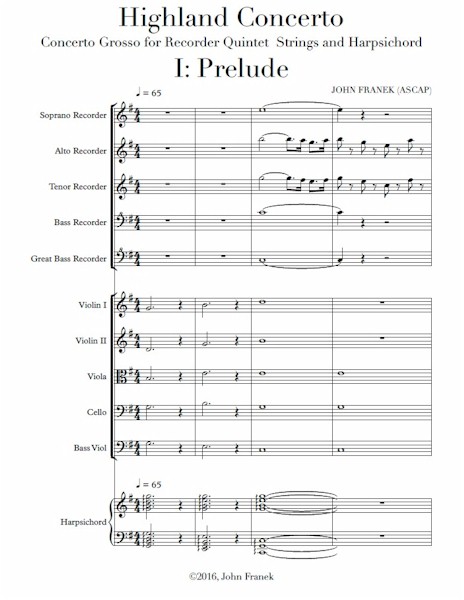
Roon's Tune
by Bradford Wright, 2017
A slow jazz piece for two altos, piano, and cello. The recorder parts are mostly in parallel, making it accessible for intermediate players. There are simultaneous end-stopped notes in the recorder parts toward the end (you may need to look up the fingerings), which add some dramatic effect.
Preview Sound Sample
Download
MP3 file
Fugue on an Old Moo Call
by Gary Meyer, April 2018
This is an ancient call to bring the cows out of the field heard on the internet. (Song of Nature Jona Jinton). I found the challenge to write this as a fugue. I wrote this in Finale as a flute and string quartet.
Preview Sound Sample
Download
MP3 file
Tango on a Ground
by Bradford Wright, 2017
As the name suggests, this is a tango with a ground. The instrumentation is two alto recorders, piano, and long-suffering cello. It is easy to play. Some say it has a Theremin-like quality to it. My guess is that you will love it or hate it. This is a companion piece to Roon's Tune.
Preview Sound Sample
Download
MP3 file
Cool Cat Rooney
by Bradford Wright, 2018
Another in the series of jazzy new music for two recorders, piano, and cello. Intermediate level. Rooney the cat personally supervised the composition. The rolled chords at the end on the mp3 are too fast, but it was the best that I could get.
Preview Sound Sample
Download
MP3 file
Swing Lower, Sweet Chariot
by Bradford Wright, 2018
This is a jazzy take on the spiritual Swing Low Sweet Chariot. I originally wrote this piece for men's choir (freely available on request) with some added text. I discovered that it also works very well with low recorder choir, and could be useful as a prelude in church. Playing level is intermediate, but it takes some practice to polish the transitions.
Preview Sound Sample
Download
MP3 file
Plain and Fancy
by Gary Betts, July 2018
This is a whimsical piece in rondo form for SATB recorders. The "Plain", or "A" section is a straight forward hymn-like tune, which alternates with the "Fancy", or "B" and "C" sections, which occur when the players have ingested the schnapps in their pie. Players are encouraged to adopt appropriate postures and slight upper body movements where appropriate.
Preview Sound Sample
Download
MP3 file
La Grenouille Bondissante (Rondeau)
by Gary Betts, June 2018
This is a take on the 18th century rondeau form and style. Keep strict rhythms. Inegale eighth notes are all written out, as some eighth note figures are inegale, and some not, but not adhering strictly to the 18th century French inegale rules. It is important that regular rhythms are not altered to attempt matching the inegale rhythms in another part (i.e. in a dotted quarter-eighth note figure, play the eighth note exactly on the "and" of the second beat of the figure. Do not delay and shorten it to match an inegale figure occurring simultaneously in another part). The fermata and cut before the last rondeau section is optional. If the piece needs to be abridged, the first ending and repeat of the initial rondeau section may be omitted. Note tempo changes at the last couplet and final rondeau.
Preview Sound Sample
Download
MP3 file
Jamboree
by Bruce Sankey, 2013
This lively piece is intended to capture the spirit of exuberance exhibited by a crowd of young folk (or older folk) participating in some outdoor activity. The rhythm is repeated and momentum maintained all the way through.
Preview Sound Sample
Download
MP3 file
"La Folia" Fantasy Variations
by Anthony St. Pierre, May 2018
Anthony St. Pierre (b. Schenectady NY, 1956) has composed well over a dozen Folia variation sets for diverse media, including sets for 1, 2, 3, & 4 recorders, and one for alto recorder & piano. This set of four variations for a solo sopranino may be played to good effect on the alto as well. It qualifies as a "fantasy" because there is no bar-for-bar or beat-for-beat correspondence between the theme and each variation. In this way, it differs from most other Folia variations. It is suitable for a fairly accomplished player. Duration: 5'30" Performed by Anthony St. Pierre, sopranino
Preview Sound Sample
Download
MP3 file
La Folia à 2
by Anthony St. Pierre, May 2018
Anthony St. Pierre has composed Folia variations for many media, including for 1,2,3,&4 recorders, as well as alto recorder & piano. The nine variations in this set for alto and tenor recorders are in a modern idiom, but traditional forms (Gavotte, Chaconne, Fugato) are featured. The piece requires moderately advanced technical skill. Duration: 11'20" Performed by Scott Paterson, alto; Anthony St. Pierre, tenor
Preview Sound Sample
Download
MP3 file
The Mosquito's Courtship
by Anthony St. Pierre, July 2005
The Dance of the Mosquitos of Heitor Villa-Lobos inspired this frenetic duet for sopranino recorders.
At tempo, this piece is best suited to advanced players. The stem barring in bb.52-3 indicates flutter tonguing. Duration: 1:10 Performed by Scott Paterson and Anthony St. Pierre, sopraninos
Preview Sound Sample
Download
MP3 file
Around on a Ground for Alto and Bass Recorder
by Anthony St. Pierre, March 2009
In composing for recorders, Anthony St. Pierre has frequently taken inspiration from Henry Purcell. In Around on a Ground, he cyclically applies modal alterations to each iteration of the ground from the so-called Bell Anthem, Rejoice in the Lord Alway, of Purcell. The ground passes alternately from the alto to the bass recorder.
Players of intermediate ability will find approachable challenges in this duet. Duration: 1:45 Performed by Scott Paterson, alto; and Anthony St. Pierre, bass
Preview Sound Sample
Download
MP3 file
Glass Menagerie for Sopranino, Soprano, Alto, and Bass Recorders
by Anthony St. Pierre, August 2010
An essay in minimalism, Glass Menagerie is a perpetuum mobile employing a motif with shifting agogic stress at superposed quarter, eighth, and sixteenth note levels of diminution/augmentation.
The piece is technically undemanding, but the sopranino does have a moment in its extreme high register. Duration: 3:00 Performed by Takayo Shimoda, sopranino; Tatsuki Shimoda, soprano; Anthony St. Pierre, alto; Scott Paterson, bass
Preview Sound Sample
Download
MP3 file
Canonic Chaos on Old 100th for Alto, Tenor, Bass, and Great Bass Recorders
by Anthony St. Pierre, January 2009
Based on the Louis Bourgeois tune for the 100th Psalm (Praise God from Whom All Blessings Flow, or All People that on Earth do Dwell ) of 1551, this quartet is, like the Glass Menagerie quartet, which Anthony St. Pierre has also made available through the ARS, a perpetuum mobile featuring modally altered canonic treatment of the tune superimposed on the unaltered form of itself.
The piece poses no notable technical challenges, but phrases are long and in places, unrelenting. Duration: 1:45 Performed by Janos Ungvary, alto; Anne Massicotte, tenor; Anthony St. Pierre, bass; Scott Paterson, great bass
Preview Sound Sample
Download
MP3 file
Pholia for Alto Recorder and Piano
by Anthony St. Pierre, May 2006
The famous Folia of Corelli was the inspiration for Pholia* for alto recorder and piano. The intent was to provide a modern alternative to the Corelli, which, although composed for the violin, has long been a staple of the recorder repertoire. (The edition for recorder appeared just two years after the original violin version.)
Although not as lengthy (duration: 8:40), the Pholia offers a wider variety of keys, modes, harmonies, textures, and meters than the Corelli. The piano is not subordinate to the recorder in the Pholia; it participates equally in each variation. Performed by Anthony St. Pierre, alto; Larry Green, piano
* So spelled to distinguish from other Folias
Preview Sound Sample
Download
MP3 file
Windows for Alto and Bass Recorder
by Anthony St. Pierre, August 2009
The inspiration for this duet was the shutdown motif (doh’-sol-doh-re) of the Windows operating system I was using at the time of composition. I combine it contrapuntally in various ways with its inversion. Technical demands are moderate. Duration: 2:00.
Preview Sound Sample
Download
MP3 file
Song of a Siren for Alto Recorder and Piano
by Anthony St. Pierre, 2009
The siren motif from the third of Debussy’s Nocturnes inspired this piece for alto recorder and piano. The harmonic idiom, however, recalls that of Messiaen. (The YouTube recording of the work bears its original title, Mouvement Messiaenique.) Duration: 3:30 Performed by Anthony St. Pierre, alto and piano
Both the recorder and piano parts are quite accessible to players of intermediate skill, but strong dynamic contrasts are necessary to bring the music to life. For ease of movement between the low g-sharp and f-sharp at the end of the piece, half hole with the pinky for both notes, relaxing the ring finger as much as possible; do not allow it to bear down. A little of the skin’s own natural oil on the tip of this finger will help ease the glide from half to full hole. As well, a slight separation of the two pitches will permit clean movement from one to the other.
After listening to the recording on the YouTube, players may wish to play to the piano accompaniment provided here. Note however that the fermata in b.21 is omitted to facilitate simultaneous re-entries b.23. In b.54, the accompaniment adds 2 extra half note beats to the fermata, and four half notes at the end (b.56).
Preview Sound Sample
Download
MP3 file
YouTube recording
Piano Accompaniment MP3 file
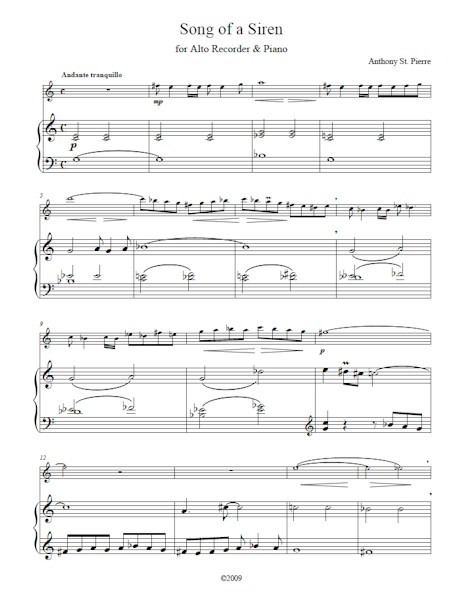
La Folia à 4 (SATB)
by Anthony St. Pierre, July 2007
Anthony St. Pierre (b. Schenectady NY, 1956) has composed well over a dozen Folia variation sets for diverse media, including sets for 1, 2, 3, & 4 recorders, and one for alto recorder and piano. La Folia for 4 (SATB) took 3rd place in the ARS Chicago Chapter's composition competition in 2007. It presents nine variations in contrasting but complementary styles. It is suitable for a fairly accomplished players. Duration: 7:30 Performed by Anthony St. Pierre, soprano; Scott Paterson, alto; Tatsuki Shimoda, tenor; Takayo Shimoda, bass
Preview Sound Sample
Download
MP3 file
Sonata da chiesa for Two Soprano Recorders and Continuo
by Anthony St. Pierre, September 2007
The triosonata, the sonata for two treble instruments and a bass, was one of the most popular forms of instrumental chamber music of the baroque and the Italian violinist, Archangelo Corelli, a universally renowned and influential composer in this genre. He composed two varieties of triosonata: the largely terpsichorian sonata da camera, and the sonata da chiesa or church sonata, founded on the organ idiom of the 17th century.
The present triosonata is of this second variety. The harmonic idiom, perhaps evoking Stravinsky in places, is thoroughly modern, but the overall form and the melodic style remain very "Corellian" hence the subtitle, The Modern Corelli. (An earlier subtitle, appearing on the SoundCloud recording, was Il Aggiornamento, meaning an "updating" or "renovation.") The piece is light-hearted parody.
Players of intermediate skill will be comfortable with the technical demands. Ideally, the two soprano recorders will be accompanied on the organ (8-ft. flute stop) Alternatively, the harpsichord is acceptable. The bass part (cello) is optional.
Players may wish to play to the accompaniment provided here. In each of the four movements, the two recorders begin with the organ, so a count-in is necessary. Players must take note that the beat immediately before the downbeat is a one-beat rest (silence). So for a six-beat count-in, the players hear: 1-2-3-4-5-[rest]-|play; a four-beat would be 1-2-3-[rest]-|play, etc. The rest is of course where they breathe.
Duration: 7:00 Performed by Scott Paterson and Anthony St. Pierre, sopranos; and Anthony St. Pierre, organ
Preview Sound Sample
Download
MP3 file
Accompaniment
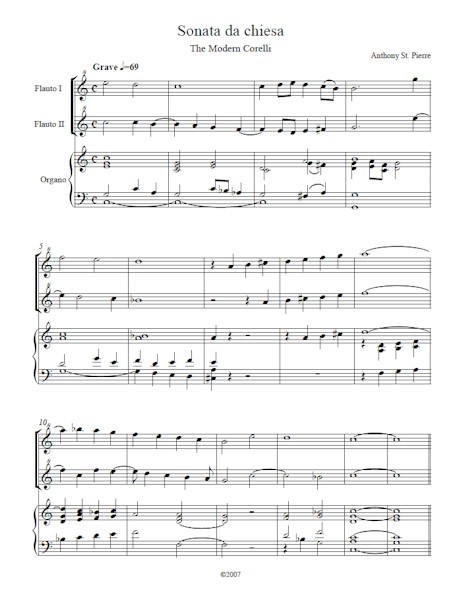
A Thom Tallis Fancy for Alto (Sopranino) and Tenor Recorders
by Anthony St. Pierre, June 2006
A review appears in the Spring 2015 issue of the AR (p. 39).
In the first of the three sections, the alto takes the Tallis tune, which most audiences know from the famous Vaughan Williams Fantasy on a Theme by Thomas Tallis. The tenor presents the tune in the middle section. In the final section, the alto takes up the sopranino (optionally) and the two voices deliver the tune imitatively.
Players of intermediate ability will encounter few technical difficulties in this piece. Duration: 3:40 Performed by Anthony St. Pierre, alto, sopranino; Scott Paterson, tenor
Preview Sound Sample
Download
MP3 file
Fantasy on 'Schenectady' for SATB recorders
by Anthony St. Pierre, December 2010
The Fantasy on 'Schenectady' might recall the Americana style of composers like Aaron Copland or Virgil Thompson. In 1801, Nehemiah Shumway of Schenectady, New York published a shape-note fuguing tune that he named 'Schenectady.' It is in the primitive style best known in the work of William Billings. (The composer is, himself, a native of Schenectady.)
Possibly the greatest challenge in this quartet is achieving pure tuning in the bare octaves and fifths, as well as in the parallel octave passages. Triple-barred note stems indicate flutter tonguing. Tricky entries for the tenor are eased with cues above the staff. Duration: 6:20 Performed by Scott Paterson, soprano; Anthony St. Pierre, alto; Anne Massicotte, tenor; Janos Ungvary, bass
Preview Sound Sample
Download
MP3 file
Menuet Pastoral (SATB)
by Anthony St. Pierre, March 2008
The sustained low F in the bass lends a pastoral quality to this minuet & trio. The style might be described as 20th-century English. Despite chromatic notes, the moderate tempo makes this brief piece (3:45) quite accessible to intermediate players.
Performing on the ARS website recording: Takayo Shimoda(S); Anthony St. Pierre (A); Janos Ungvary(T); Scott Paterson(B)
Preview Sound Sample
Download
MP3 file
Pentatonic Fughetta (SSA)
by Anthony St. Pierre, April 2005
Although brief (1:30), this fughetta on a pentatonic subject covers a variety of transpositions and appears in inversion and augmentation. Statements in Db bear some examination before a play-through, but at the suggested tempo, the piece, not withstanding these passages, is feasible for players of intermediate skill.
On the ARS website recording, the performers are: Scott Paterson and Anthony St. Pierre, sopranos; Janos Ungvary, alto.
Preview Sound Sample
Download
MP3 file
Wombats' Waltz (ATB)
by Anthony St. Pierre, December 2005
The title is just an alliterative gimmick — wombats do not waltz! This name however seems to have piqued the curiosity of many YouTube viewers who were perhaps expecting to see some sort of wombat ritual. The piece is a five-part rondo and presents no particular technical difficulties. Duration: 2:15
On the ARS website and YouTube recording, the performers are: Janos Ungvary, alto; Anthony St. Pierre, tenor; Scott Paterson, bass
Preview Sound Sample
Download
MP3 file
Marche Malo (SAT)
by Anthony St. Pierre, December 2005
This march in ABA form has nothing to do with Malo. It is merely a fanciful, alliterative title. It may recall the style of Kabalevsky’s Opus 27 piano pieces for children. The piece will prove quite straight-forward for an ensemble at the intermediate level. Duration: 1:45
The performers on the accompanying recording are Scott Paterson, soprano; Anthony St. Pierre, alto; Janos Ungvary, tenor.
Preview Sound Sample
Download
MP3 file
Missa 'Cum Jubilo' Fantasia (AATB)
by Anthony St. Pierre, June 2007
A frequent source of inspiration for this composer is the repertoire he learned as a choirboy. The Gregorian Missa cum jubilo was the genesis for his highly morphed version of this mass setting, from which he has treated the Kyrie, Sanctus & Benedictus, and Agnus Dei. Passages in octaves will require careful attention to tuning and there are some tricky syncopations, but overall an ensemble of moderate skill will find this piece approachable. The last movement (Agnus Dei) may be played on the great bass, in which case, a low D is preferred in the final bar. Duration: 4:00
In the accompanying recording the performers are: Scott Paterson & Anthony St. Pierre, altos; Anne Massicotte, tenor; Takayo Shimoda, bass.
Preview Sound Sample
Download
MP3 file
L'Intersidéral (sTT)
by Anthony St. Pierre, April 2008
A flying saucer (2 tenors) lands on Earth, a space alien (sopranino) emerges, looks around, offers a few remarks, but quickly departs.
The piece should be performed in a very lively acoustic. Portions marked "lointain" ("distant") should be played from, or near, off stage if possible. A bold wavy line indicates a slow, heavy vibrato, a lighter one, a faster, less intense vibrato. Slide fingers off tone holes to achieve the glissandi. Duration: 1:30
The accompanying multitrack recording features the composer playing sopranino and tenor II, with Scott Paterson, tenor I
Preview Sound Sample
Download
MP3 file
Shepherds' Gigue (SA)
by Anthony St. Pierre, December 2005
Composed for a Christmas celebration, this lively, highly syncopated gigue featuring the interval of a fourth throughout suggests the joy of the "shepherds abiding in the field." Suited for fairly advanced players, the piece is but a minute long.
Performing on the accompanying recording are Scott Paterson, soprano; and Anthony St. Pierre, alto
Preview Sound Sample
Download
MP3 file
Fanfare à 3 (SSA)
by Anthony St. Pierre, August 2009
One can easily imagine this fanfare in ABA form played on trumpets, as the three high recorders have a similar brilliance. Features include quartal harmonies, parallel triads, and hemiola. Although lively, its technical demands are well within the command of intermediate players. Duration: 2:15
Performing on the accompanying recording are the composer, with colleagues, Takayo Shimoda, and Scott Paterson.
Preview Sound Sample
Download
MP3 file
Berceuse Basse ([T]B/B/B/gtB)
by Anthony St. Pierre, February 2014
This gentle five-part rondo is a lullaby that in places, may recall the harmonies of Stravinsky. If preferred, Bass I may be played on the tenor from the transcription included with the parts. The piece poses little technical difficulty for players of intermediate skill. Duration: 2:15
Playing on the accompanying recording are the composer, Bass I; Anne Massicotte, Bass II; Janos Ungvary, Bass III; Scott Paterson, Great Bass
Preview Sound Sample
Download
MP3 file
Pavane & Galliard (ATT)
by Anthony St. Pierre, December 2005
This piece fuses the form and style of the well-known Renaissance dance pair, the Pavane & Galliard (Peacock Strut & Hen Hop) with harmonies that may be likened to those of Milhaud. A trio of intermediate skill will find this score feasible. Duration: 2:15
Janos Ungvary (alto), Scott Paterson (tenor I), and the composer (tenor II) perform on the accompanying recording.
Preview Sound Sample
Download
MP3 file
Variation on Handel's 'Pifa' (SSTT)
by Anthony St. Pierre, November 2005
How nice it would have been had Handel included recorders in the Pifa (Pastoral) of Messiah! This variation is a colorful morph in which strains of the original are still much in evidence. An intermediate group may undertake it with confidence. Duration: 3:30
The quartet on accompanying recording is: the composer (S1), Takayo Shimoda (S2), Scott Paterson (T1), & Janos Ungvary (T2).
Preview Sound Sample
Download
MP3 file
Phrygian Impromptu (unaccompanied S or T)
by Anthony St. Pierre, August 2005
This brief (approx. one minute) piece features conjoined phrase halves that are rhythmic mirror images of each other. (i.e. duple eights, triplet eights, sixteenths, then the reverse). Each phrase is on the phrygian scale a fifth higher than the previous until the midpoint, where the sequence of transpositions is reversed (i.e. c, g, d, a, then the reverse) before a codetta. The performer should play very freely, as if improvising. The score appears here for C recorders, but it may be transposed for F instruments if desired.
The composer plays on the accompanying recording.
Preview Sound Sample
Download
MP3 file
Lament (SATB)
by Anthony St. Pierre, March 2011
This mournful piece in ABA form was inspired by the work of Alan Hovhaness and composed in observance of Hovhaness' 100th birthday. (Cantillation, the third of three duets for bass and great bass recorders by St. Pierre, also reflects Hovhaness' style and is available on the ARS website.)
Finger vibrato is indicated by wavy lines. Glissandi are executed by sliding fingers on and off the tone holes. The piece is recommended for performers of advanced skill. Duration: 3:00
The quartet playing on the accompanying recording is: Takayo Shimoda (S); Tatsuki Shimoda (A); Anthony St. Pierre (T); Scott Paterson (B)
Preview Sound Sample
Download
MP3 file
Canon @ Quinta (SA)
by Anthony St. Pierre, February 2008
This canon at the fifth features contrasting sections that are variants of the first. Chromatic passages present some challenges. Duration: 2:00
The accompanying recording features Scott Paterson (S), and the composer (A).
Preview Sound Sample
Download
MP3 file
Canon @ Nona (ST)
by Anthony St. Pierre, September 2007
This brief canon at the ninth (approx. 1:30) in ABA form features a largely quartal tune in the A sections that contrasts with a primarily scalar B section. Players of upper intermediate skill will find it approachable.
Players on the accompanying recording are the composer (S) and Scott Paterson (T).
Preview Sound Sample
Download
MP3 file
Etude (SS)
by Anthony St. Pierre, February 2008
Etude is a 12-note serial piece in ABA form founded on the Circle of Fifths. It is more a study ("etude") in compositional technique than in instrumental skill development. Apart from some rhythmic complexities, it poses few technical challenges that a player at the upper intermediate level could not match. Duration: 2:20
The composer and Scott Paterson perform on the accompanying recording.
Preview Sound Sample
Download
MP3 file
Vocalise à 2 (TT)
by Anthony St. Pierre, February 2006
This largely pentatonic duo in which parallel fifths are prominent recalls the pastoral idiom of Vaughan Williams. The triple beams over halfnotes indicate a rapid trill or tremolo. There are some rapid, breezy passages to negotiate, but the absence of chromatic notes there facilitate their execution.
Duration: 2:30
Playing on the accompanying recording are Scott Paterson and the composer.
Preview Sound Sample
Download
MP3 file
Implosions (Sopranino/Alto)
by Anthony St. Pierre, May 2008
Because of its structure (P5up, P4down, M3up, M2down, m2up), the six-note theme and its inversion, which generate a series of variations, seems to implode on itself. Rhythms are tricky in spots and light double tonguing is called for. Duration: 2:10
Scott Paterson (sopranino) and the composer (alto) perform on the accompanying recording.
Preview Sound Sample
Download
MP3 file
Mayday! (2 Sopranini)
by Anthony St. Pierre, September 2006
This frenetic duet in 7/8 is founded on ten iterations of the Morse Code for the "Mayday" distress signal (from French "Venez m'aidez," "Come Help Me.") The odd meter, brisk tempo, preponderant dissonances, and the shrillness of the sopranino recorders impart urgency and distress. There are no significant technical complications. The coda (ad infin.) maybe be played over as desired, gradually fading away, perhaps as performers recede from the performance space. Duration: 1:00 Players are encouraged to investigate another of the composer's Morse-based works, S-O-S (SATB), in the Members' Library Editions (No. 30).
Scott Paterson and the composer play on the accompanying recording.
Preview Sound Sample
Download
MP3 file
Lydian Impromptu (A)
by Anthony St. Pierre, February 2008
Like the Phrygian Impromptu, also available on the ARS website, the Lydian Impromptu uses mirror image rhythmic melodic construction (i.e. the rhythm of the first half of the tune reverses itself in the second half). Except for a brief passage in Db (Lydian scale), there are no particular technical complications. Duration: 1:45
The composer performs on the recording offered here. The recorder is a Zen-on alto after Bressan.
Preview Sound Sample
Download
MP3 file
Fuga alla moda
by Bradford Wright, October 2018
This is a jazzy fugue for soprano, alto, tenor, and great bass recorders with bongo drums accompaniment. I have not run across anything like it in the recorder repertoire. It has a lot of accidentals, but is not particularly hard. A courtesy part for great bass in treble clef is included. There is also a performance suggestion that some groups may be able to use or adapt.
Preview Sound Sample
Download
MP3 file
Mere Bagatelle No. 1 (SA)
by Anthony St. Pierre, July 2006
This scherzo in ABA form was inspired by Kabalevsky's Op.27, No.5 for piano. It is one of a series of brief bagatelles for various combinations of recorders. (No. 4 [AAA] appears in the ARS Members' Library Edition, Edition No. 55.) While not technically challenging, co-ordination of the two parts is tricky when playing at tempo and some slow practice will not go amiss. Parallel octaves require careful attention to tuning. Duration: 1:05
Scott Paterson and the composer are the performers on the recording on this webpage.
Preview Sound Sample
Download
MP3 file
Mere Bagatelle No. 2 (SA)
by Anthony St. Pierre, July 2006
Like Mere Bagatelle No. 1 (also available on the ARS website), Mere Bagatelle No. 2 is a brief scherzo in ABA form. Aside from some brief rhythmic complexities, it is technically uncomplicated. Duration: 1:10
Scott Paterson (S) and the composer (A) play on the recording presented here.
Preview Sound Sample
Download
MP3 file
Perpetuum Mobile à 2 (SS)
by Anthony St. Pierre, September 2005
This energetic duet in ABA form is largely in the Phrygian mode. Strong contrasts in dynamics and articulation are necessary for an effective performance. A tempo of 100/quarter note is ideal. Players will enjoy a good workout on scales and arpeggios. Duration: 2:00
Preview Sound Sample
Download
MP3 file
Re-Invention I (AT)
by Anthony St. Pierre, September 2012
Inspired by inept attempts to play the Bach Two-Part Inventions, the composer was inspired to "distort" several of them for various recorder combinations. The present re-invention is based on the E major invention. Although very chromatic, it is not particularly challenging to play. Duration: 4:30
Presenting the piece on the accompanying recording are Scott Paterson (A) and the composer (T).
Preview Sound Sample
Download
MP3 file
Re-invention II (SB)
by Anthony St. Pierre, July 2013
This "corruption" of Bach's F major Two-Part Invention was inspired by the composer's inept attempts to play the piece at the keyboard. When played up to tempo, it will prove challenging. Duration: 1:15
Scott Paterson (S) and the composer (B) play on the recording presented here.
Preview Sound Sample
Download
MP3 file
Re-invention IV (SB)
by Anthony St. Pierre, January 2017
This duet is a fleshed-out fantasy on Bach's Bb major Two-Part Invention. It is suitable for advanced players. Other such "re-inventions" by the composer are available on the ARS website. Duration: 2:05
The composer (S) and Scott Paterson (B) perform on the recording presented here.
Preview Sound Sample
Download
MP3 file
Re-invention V (SB)
by Anthony St. Pierre, January 2017
Like the composer's other re-inventions (also available on the ARS website), this warped, yet quite recognizable morph of a Bach Two-Part Invention is fairly challenging when played at tempo. It is founded on the G major invention. In the accompanying recording, Scott Paterson (S) and the composer (B) are heard. Duration: 1:05
Preview Sound Sample
Download
MP3 file
Fantasy on Frère Jacques (SAT)
by Anthony St. Pierre, August 2005
Mahler had fun with this tune in his Symphony No. 1. This more modestly proportioned treatment of Frère Jacques was inspired in some measure by Bartok's Mikrokosmos. Players of intermediate skill will find this trio well within reach. Duration: 1:50
The players on the accompanying recording are: Takayo Shimoda (S); Anthony St. Pierre (A); & Scott Paterson (T).
Preview Sound Sample
Download
MP3 file
La Barsan (ATB optional sopranino)
by Anthony St. Pierre, March 2008
This three movement trio, based on a solo sonata by Philibert de Lavigne (c.1700-1750), treats the original music in a harmonic idiom similar to that in Milhaud's Suite D'Après [Michel] Corrette, a contemporary and compatriot of Lavigne. The title may refer to a patron of Lavigne. Optionally, a sopranino may provide sprightly contrast to the alto in Tambourin I. Players with experience playing the baroque sonata repertoire will have little trouble bringing this work off. Duration: 7:30.
Scott Paterson (A), the composer (T), & Takayo Shimoda (B) perform on the recording offered here.
Preview Sound Sample
Download
MP3 file
Chaconne à 3 (ATT)
by Anthony St. Pierre, June 2003
The structure of the four-bar ground is: quartal triad; augmented triad; 7th triad; major triad. A few rhythmic twists aside, this trio will not prove searchingly difficult for intermediate players. In bb. 44-5, the alto plays a Db, combining flutter tonguing and finger vibrato; before quitting the note, however, only the vibrato persists. Duration: 1:50
The players on the accompanying recording are: Scott Paterson (A), the composer (T1), and Tatsuki Shimoda (T2)
Preview Sound Sample
Download
MP3 file
Four Modal Limericks (S[T] and voice)
by Anthony St. Pierre, February 2004
These settings of limericks by Edward Lear (1812 - 1888) feature recorder obbligato. The four church modes - dorian, phrygian, lydian, and mixolydian - are employed in the 1st, 2nd, 3rd, and 4th songs, respectively. The bright soprano recorder is appropriate to the 1st, 3rd, and 4th, while the tenor is suggested for the melancholy affect of the second. These very brief songs are apt for young audiences. Duration: 3:00
The informal recording offered here features Jenny Cohen, mezzo-soprano, and the composer.
Preview Sound Sample
Download
MP3 file
Ten Childhood Pieces (trios: variously sSATB)
by Anthony St. Pierre, March and April 2008
These little trios evoking scenes of childhood were inspired by the playful and reflective styles of Dimitri Kabalevsky. They are:
On the Playground; Lullaby; Bongo Drums; Merry-Go-Round; Clip-Clop; Hommage to Robert Schumann (op. 15, no. 1); Quip; Little Rondo; Tommy Guns; The Chase
The Prince Consort plays on the recording offered here (which does not include The Chase). Duration: 12:00
The rapid double tonguing in some of the movements may be the most challenging aspect of performance. Any or all of the pieces may be played in any order. They are well suited to school concerts. Also appropriate is the composer's L'intersidèral (Outer Space) trio, likewise available on the ARS website.
Preview Sound Sample
Download
MP3 file
And No Umbrella, Far and Away Trio Part 2 (TTB)
by Jeannette Bertles, January 2013
This composition is part 2 of a Trio for two tenors and a bass. Part 1, Far and Away, was published as an ARS Members' Library Edition in Summer 2018, No. 64. Part 3, Close Quarters, is published below.
Preview Download
Close Quarters, Far and Away Trio Part 3 (TTB)
by Jeannette Bertles, January 2013
This composition is part 3 of a Trio for two tenors and a bass. Part 1, Far and Away, was published as an ARS Members' Library Edition in Summer 2018, No. 64. Part 2, And No Umbrella, is published above.
Preview Download
Four Lutheran Chorales for Advent (SATB)
by Anthony St. Pierre, October 2009
Inspired by numerous modern organ settings of Lutheran chorales, the composer has set four of the best known for Advent. Any or all may be played (perhaps as part of a church service or Christmas season recital) and in any order. They lie well within the means of intermediate players. Duration: 9:30
The Prince Consort performs on the accompanying recording.
Preview Sound Sample
Download
MP3 file
Nun danket Alle Gott Partita (unaccompanied soprano)
by Anthony St. Pierre, 1993
This is a rather challenging solo partita (set of variations) on a famous Lutheran chorale often sung at festive occasions, including weddings. It is fundamentally in the German high baroque style. On the recording, the composer plays over the tune before beginning the five variations. For ease of execution, he plays the third variation on the sopranino (as suggested in the score). Performers should take care to distinguish between the short trill and the mordent, which has a subtle, easily missed vertical stroke through it. Duration: 9:30
Preview Sound Sample
Download
MP3 file
Sinfonietta (SAT/TBgtB)
by Anthony St. Pierre, October 2005
In many of his recorder compositions, this composer adapts the styles of composers who never wrote for recorders such as Dimitri Kabalevsky, whose music inspired this trio in small-scale, four-movement symphonic form. The initial theme of the first movement re-appears in the fourth movement (Letter C), making the whole, to an extent, cyclical. At a duration of 17:45, it is suitable recital material.
The Prince Consort performs on the accompanying recording.
The unrelenting accompaniment makes the first movement somewhat of a test of endurance. However, the composer has marked parenthetically points where a note may be dropped if a breath is necessary. This piece is suited to fairly advanced players.
For contrast in timbre, the second movement may be played on tenor, bass, and great bass. (Parts in bass clef are furnished for the latter two instruments.) The lower instruments are especially well suited to the melancholy A section of this movement. The heavy wavy line in the soprano (tenor) at b. 50 indicates finger vibrato.
The brief transitional passages in the fourth movement (bb. 44-7 and bb. 155-8) may be played solo by the soprano or, although a challenge to precise tuning, as a grand unison.
Preview Sound Sample
Download
MP3 file
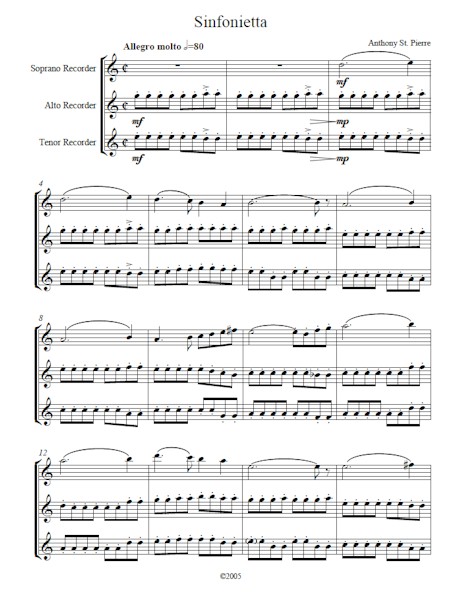
Fanfare on 'In Dulci Jubilo' (SAA/TTB)
by Anthony St. Pierre, September 2005
This thoroughly modern treatment of an ancient German carol (Good Christian Men, Rejoice) is fitting for the opening of a Christmas concert or pageant. Where numbers permit, the optional divisi in the soprano should be observed. The setting is not especially difficult. However on first reading, players may find rest counting easier if they read from the full score. Duration: 1:00
The Prince Consort performs on the accompanying recording.
Preview Sound Sample
Download
MP3 file
Coventry Carol ([A]TTB)
by Anthony St. Pierre, July 2006
This setting of the 14th-c. Coventry Carol is an arrangement of an arrangement; the original setting was for voices. It is certainly within reach for intermediate players. The optional alto (v.2) may be play in parallel with, or instead of tenor 1. Duration: 2:50
Playing on the recording provided here are: Scott Paterson, A/T1; the composer, T2, and Takayo Shimoda, B. (The composer has revised the score very sparingly since the recording was made.)
Preview Sound Sample
Download
MP3 file
Quand je suis mis (ATB)
by Anthony St. Pierre, June 2008
This is a very free adaptation of a lyrical virelai be Guillaume de Machaut (1304?-1377) in a modern idiom. Although contrasting sharply, it may well be paired with St. Pierre's setting of the lively Machaut virelai, Douce dame (sST), also available on the ARS website. Intermediate players will find this music quite accessible. Duration: 2:30
Performers on the recording here are: Scott Paterson, alto; the composer, tenor; and Takayo Shimoda, bass.
Preview Sound Sample
Download
MP3 file
Douce dame (sST)
by Anthony St. Pierre, July 2008
The composer has freely adapted this lively virelai by Guillaume de Machaut (1304?-1377) in a modern idiom, while retaining its exotic, medieval character. In recital, this brief (2:00) piece may well be paired with the more reflective Quand je suis mis, another of St. Pierre's adaptations of a Machaut virelai that is available through the ARS website. Perhaps excepting extremes of upper range in the soprano, the piece will sit well with intermediate players.
Players on the recording presented here are: Scott Paterson, sopranino; the composer, soprano; Takayo Shimoda, tenor.
Preview Sound Sample
Download
MP3 file
Partita on In Dulci Jubilo (SA)
by Anthony St. Pierre, November 2009
This brief (2:40) partita is set of four contrasting variations on the 14th-c. German Christmas tune sung to "Good Christian Men Rejoice" in English. It has its share of tricky passages and rhythmic twists lurk around every corner.
Scott Paterson (S) and the composer (A) perform on the recording offered here.
Preview Sound Sample
Download
MP3 file
Es ist ein Ros' entsprungen à 5 (SATBgtB)
by Anthony St. Pierre, November 2009
Inspired by Brahms' lush setting of this famous German carol (Lo How a Rose), the composer has written fantasy settings of the same tune for consorts of five and six voices. At the ideal tempo, deep breaths and careful control of air flow are required. Duration: 2:00
Preview Download
Es ist ein Ros' entsprungen à 6 (sAATBgtB)
by Anthony St. Pierre, November 2009
Brahms' voluptuous organ setting of this 14-th c. German carol, sung to "Lo, How a Rose E'er Blooming" in English, inspired this six-voice rendition that runs the gamut from sopranino to great bass. (A version transposed to include F-contrabass is available.) Octave doubling requires careful tuning, but the piece is otherwise uncomplicated. Duration: 1:45
The Prince Consort is heard on the accompanying recording.
Preview Sound Sample
Download
MP3 file
All and Some (SAT)
by Anthony St. Pierre, October 2008
This very easy modern harmonization of a late medieval English carol is but half a minute long. On a Christmas program, it may be presented to good effect with other more conventionally harmonized carols. This first time through, skip from b.9 to b.13. Play bb.10-12 only on the repeat. Optionally, the soprano may play an octave higher on the repeat.
The Prince Consort performs on the recording offered here.
Preview Sound Sample
Download
MP3 file
Sussex Carol (S[S]ATB)
by Anthony St. Pierre, October 2005
This is an easy setting in which the tune (lyrics: On Christmas Night all Christians sing) is backed by a campanilian accompaniment. An optional divisi appears in the soprano. Duration: 1:10
The Prince Consort performs on the recording.
Preview Sound Sample
Download
MP3 file
Jingled Bells (SATB)
by Anthony St. Pierre, October 2005
Although not at all technically complicated, the metrical shifts may jingle some bells! Many will be surprised to learn that the tune has long been in the public domain; do not let fear of a lawsuit stop you from presenting this setting in public. Duration: 1:10
Preview Sound Sample
Download
MP3 file
Discantus (ATB)
by Anthony St. Pierre, March 2010
'Discant' refers to the streams of parallel first inversion triads characteristic of Medieval English music. This quite approachable rondo combines discant with more recent harmonic idioms. Duration: 3:35
Scott Paterson, alto; Janos Ungvary, tenor; and the composer, bass, perform on the recording provided.
Preview Sound Sample
Download
MP3 file
Aria à 3 (ATB)
by Anthony St. Pierre, August 2009
This trio is in the 20th-century English pastoral style and in ABA form. Brief passages in Db major are the only technical complications one will encounter. Duration: 2:15
Playing on the recording provided here are: Scott Paterson, alto; Takayo Shimoda, tenor; the composer, bass.
Preview Sound Sample
Download
MP3 file
Suite à deux en sol (SA)
by Anthony St. Pierre, January 2006
This suite is composed of the movements characteristic of the baroque dance suite, but the style is thoroughly modern. For good measure, a gavotte, which may be played instead of, or immediately before or after the bourrée, and a pastoral, which may be played after the gigue, are included. These addenda are heard in the accompanying recording featuring the composer, soprano; and Scott Paterson, alto. The rhythmic complexities of the courante offer a particular challenge. Performers should take care to distinguish between the short trill and the mordent; the latter has a vertical stroke through it. Duration: 10:45
Preview Sound Sample
Download
MP3 file
Sarah's Bande (T/B/gtB/gtB)
by Anthony St. Pierre, March 2008
American composer Ron Nelson's orchestral 'Sarabande for Katherine in April' (1954) inspired this mellow character piece for low recorders. A relaxed tempo makes flat fraught passages quite negotiable. Great bass parts are furnished in both bass and treble clefs. Duration: 2:55
The composer (T), Janos Ungvary (B), Scott Paterson (gtB I), and Takayo Shimoda (gtB II) perform on the accompanying recording.
Preview Sound Sample
Download
MP3 file
Salicet Sarabande (ATB or TBgtB)
by Anthony St. Pierre, 1997 (arr. 2007)
'Salicet' refers to the dulcet tone of the willow pipe. This essay in ABA form is the composer's arrangement of the saraband from his Partita for Woodwind Quintet (1997). The A sections are in the phrygian mode, while the B is in the mixolydian. The ethos is best projected by low recorders (TBgtB), but the ATB version produces a satisfactory effect as well. (A G-clef copy of the great bass part is provided for players who prefer it to the standard F-clef.)
Duration: 4:00
Players on the recording here are: the composer (A), Janos Ungvary (T), and Scott Paterson (B).
Preview Sound Sample
Download
MP3 file
Suite évreuxienne (s/ATB)
by Anthony St. Pierre, August 2013
Like La Barsan (also available through the ARS website), this trio "modernizes" a French baroque suite for flute in much the same way that Darius Milhaud did in his Suite d'après Corrette (oboe/clarinet/bassoon). The present work is founded on tunes from a suite by Jacques Hotteterre, who like St. Pierre, traces his lineage to Évreux in Normandy -- hence, "évreuxienne." This music will roll off the fingers of those experienced in French baroque music. Duration: 12:40
To produce the bass low e at the end of the saraband, form a cylinder by rolling up a small sheet of paper and inserting it in the foot joint so that it projects 40-50mm from the end of the joint (as shown in the photos linked below). There is sufficient time to insert the roll after b.40. (Don't forget to remove it before proceeding to the Gavotte!)
Scott Paterson, alto/sopranino; Anne Massicotte, tenor; and the composer, bass play on the accompanying recording.
Preview Sound Sample
Download
MP3 file
Bass low E instructions
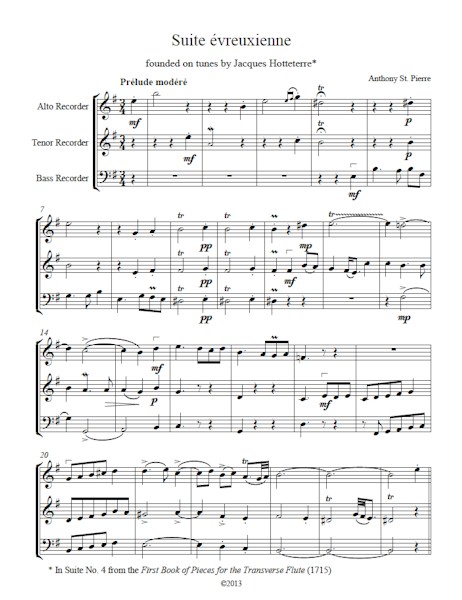
Introduction & Fantasy on 'Ave Virgo' (ATB)
by Anthony St. Pierre, May 2011
Not far into a reading of Perotin's conductus, Ave Virgo, the composer and his colleagues noted some strikingly anachronistic twists that turned out to be the result of missed accidentals! This mishap gave rise to the present decidedly modern setting of the tune (bass; bb. 33-55). Technical challenges are minimal in this essay of 2:45 duration.
Performers on the included recording of St. Pierre's instrumental setting are: Scott Paterson, alto; Takayo Shimoda; the composer, bass. A link to a YouTube choral performance of the Perotin is provided here as well.
Preview Sound Sample
Download
MP3 file
YouTube (Perotin Ave Virgo)
La Folia à 3 (ATB)
by Anthony St. Pierre, July 2018
The ARS website offers the composer's Folia variations for unaccompanied solo recorder, alto recorder with piano, for SA, and for SATB. Joining this Folia family is his set for ATB. Var. 6 is an adaptation from his Folia for string quartet. Some variations are challenging: double tonguing is required in Var. 3; the bass in Var. 6 requires quick breathing; a low b appears in the tenor in Var. 1. This is produced by half stopping the end of the instrument against the knee. (See video demonstration.) Although all voices are playing almost continuously, page turns are nonetheless feasible if parts are printed single sided. Duration: 8:30
Playing on the recording are: Janos Ungvary, alto; Anne Massicotte, tenor; the composer, bass.
Preview Sound Sample
Download
MP3 file
Video Low B on Tenor
Various Variants of Purcell Airs (trios: s/S/A/T/B)
by Anthony St. Pierre, 2007 - 2010
St. Pierre has recast this set of airs by Henry Purcell in a modern idiom. In recital, any or all may be played in whatever order seems fitting. They range in technical challenge from easy to difficult. Most are for SAT, but sopranino and bass are called for as well.
As the basis for Britten's Young Person's Guide to the Orchestra, the best known of the selections is without doubt the Rondo from 'Abdelazar." It is played on the accompanying recording by Scott Paterson (S), Janos Ungvary (A), and the composer (T).
Preview Sound Sample
Download
MP3 file
Rarifying Accretions
by Anthony St. Pierre, January 2009
Rarifying Accretions is a set of instructions for improvisation rather than a composition in the conventional sense. It is composed of 12 "cells." The first contains but a single note. Each successive cell contains one more note than the previous -- hence "accretions." The intervals between notes of each cell become progressively wider -- hence "rarifying." Full performance instructions appear on the score. The work might serve as a brief prelude on a contemporary music recital. It is especially fun to play in a lively outdoor acoustic such as can be found in a cave or canyon.
The accompanying recording by the composer offers two renderings: one on alto recorder, and another with sopranino and tenor randomly superposed. The piece is not specifically for recorders; other instruments may play instead of, or in conjunction with recorders. Contrasting ranges are desirable when two (but advisably not more) instruments play. The possibilities are infinite, so let your imagination run wild!
Preview Sound Sample
Download
MP3 file
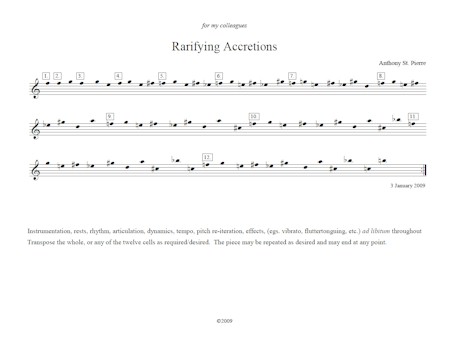
Three Lenten Chorales (SAT, opt. TBgtB)
by Anthony St. Pierre, 2010
These settings were inspired by Marcel Dupré's opus 28 chorales for organ. Players at the incipient intermediate level will find all three chorales within scope. They may be played to good effect during a Lenten church service. The composer provides a low version of Aus tiefer Not that expresses the Lenten affect particularly well. Included is a great bass part in G-clef for players who prefer it to the standard F-clef.
Performers on the recording are Takayo Shimoda (S/T); the composer (A/B); Scott Paterson (T/gtB).
Preview Sound Sample
Download
MP3 file
Pastoral Lyric (SATB)
by Anthony St. Pierre, October 2009
Like the composer's Menuet Pastoral (also available through the ARS) this quartet in ABA form is in the 20th-century English pastoral style and is quite negotiable for groups of incipient intermediate accomplishment. To facilitate page turns, print the three-page score single sided. (S turns at b. 25, ATB at b.36) Duration: 3:45
Scott Paterson (S), Takayo Shimoda (A), Tatsuki Shimoda (T), and the composer (B) play on the accompanying recording.
Preview Sound Sample
Download
MP3 file
Pentafolia (ATB[gtB])
by Anthony St. Pierre, September 2008
Pentafolia is a set of variations on La Folia in which the tune appears in various pentatonic guises, occidental and oriental. Optionally the solo variations may precede each of the three trio variants, as demonstrated in the accompanying recording. The addition of the great bass in Variation III is also optional. Pentafolia is one of various and sundry St. Pierre Folia settings available through the ARS. Groups of intermediate accomplishment will find the present set quite straight forward. Duration: 5:20
Heard on the recording are the composer (S/A), Janos Ungvary (T), Takayo Shimoda (B), Scott Paterson (gtB).
Preview Sound Sample
Download
MP3 file
Salix Gardens (SATB)
by Anthony St. Pierre, September 2008
Perhaps best known through Benjamin Britten's vocal setting, this version of the Irish folk tune Down by the Salley Gardens (Salley=Salix=Willow) is suitable for fairly inexperienced players, but will prove satisfying to seasoned players as well. Duration: 2:20
Scott Paterson (S), Takayo Shimoda (A), Janos Ungvary (T), and the composer (B) perform on the accompanying recording.
Preview Sound Sample
Download
MP3 file
The Moreen (sATB)
by Anthony St. Pierre, October 2008
This ancient and famous Irish tune is best known to the words of Thomas Moore: "The Minstrel Boy to the War has Gone." The extreme high end of the sopranino is required, but overall the piece is quite undemanding. Duration: 1:30
Other Irish tunes that St. Pierre has set for recorder quartet and that are available on this website are Salix Gardens and St. Paddy & Deidre.
Scott Paterson (s), Takayo Shimoda (A), Janos Ungvary (T), and the composer (B) play on the recording presented here. (Note Paterson's judicious ornamentation on the repeat.)
Preview Sound Sample
Download
MP3 file
St. Paddy & Deirdre (SATB)
by Anthony St. Pierre, February 2009
The Irish composer Sir Charles Stanford juxtaposed two traditional Irish airs, St. Patrick's Breastplate and Deidre, to form the Trinity Sunday hymn "I bind unto myself today." In the present adaptation of these tunes however, the two are superposed, Deidre forming a descant to St. Paddy. This is one of three Irish folk tune settings St. Pierre has made available to the ARS through this website. All three make minimal technical demands on players. Duration: 1:30
Playing on the recording here are Scott Paterson (S), Takayo Shimoda (A), Janos Ungvary (T), and the composer (B).
Preview Sound Sample
Download
MP3 file
A Royal Concert (SAB)
by Anthony St. Pierre, November 2015
Like his La Barsan and Suite évreuxienne trios (also available on the ARS website) the composer's A Royal Concert, based on François Couperin's second suite in Les Gouts réunis, applies a modern patina to a product of 18th-century France as Darius Milhaud does in his Suite d'après [Michel] Corrette (oboe, clarinet, bassoon). Players adept at the French baroque style will readily undertake this setting. Duration: 15:00
On the accompanying recording are the composer (S), Anne Massicotte (A), and Scott Paterson (B).
Preview Sound Sample
Download
MP3 file
Chorale Bicinia (various pairings: S/A/T/B/gtB)
by Anthony St. Pierre, 2010 - 2014
In this set of well known Lutheran chorales, the composer employs modern contrapuntal techniques, yet all eight duos are modeled on the chorale bicinia of Michael Praetorius. In two cases, versions for different pairings are offered. Also available from the ARS are three of St. Pierre's chorale bicinia for Lent. The recorded example presented here, Ein feste Burg (A Mighty Fortress), features the composer playing alto, and Scott Paterson, bass. Players of intermediate skill will have little trouble playing these brief pieces.
Preview Sound Sample
Download
MP3 file
Diverse Shades of Greensleeves (ST)
by Anthony St. Pierre, March 2018
This brief duet (4:45) offers just the right challenge for intermediate players. Based on a very well known tune, audiences, always alert for the familiar within the unfamiliar, will undoubtedly appreciate this set of variations, which runs the affective gamut -- hence, "diverse shades."
The composer has also composed 'A Greensleeves Fantasy' for alto recorder and piano, published in the UK by Peacock Press (PRM 009). (A link to a performance on YouTube is provided.)
Anthony St. Pierre (S) and Anne Massicotte (T) play on the recording furnished here.
Preview Sound Sample
Download
MP3 file
YouTube performance 'A Greensleeves Fantasy'
Balm (ATBgtB)
by Anthony St. Pierre, June 2009
Balm is a tranquil sonatina. By rolling and taping a small slip of paper (10 X 10cm), one can fashion a tube to insert in the foot of the bass that enables the production of the low e in the last bar. (See accompanying photos.) Repeated notes marked with dashes under a slur are to be articulated with a gently pulsing breath (equivalent to louré bowing) rather than with the tongue. Eighth-notes are to be played with a slight lilt. The piece makes no notable technical demands. Duration: 4:40
Given the music's affect, it was ironic that a thunderstorm broke during its recording! (The composer hopes produce a new recording soon.) Performing on the present recording are: Janos Ungvary, alto; Takayo Shimoda, tenor; the composer, bass; Scott Paterson, great bass.
Preview Sound Sample
Download
MP3 file
Bass Low E Instructions
Tambourin (STB)
by Anthony St. Pierre, September 2013
One of a series of fantasy adaptations of Jean-Philippe Rameau's Tambourin (Pièces de clavecin en concert No. 3), given the brisk tempo it demands, this trio is best suited to advanced players. Duration: 3:15
The composer has made minor modifications to the score since the accompanying recording was made. It features Janos Ungvary (S), the composer (T), and Scott Paterson (B).
Preview Sound Sample
Download
MP3 file
Relays (SATB)
by Bradford Wright, January 2019
This piece was inspired by watching a track relay race. The alto player will need to locate, and get familiar with, the indicated items, or devise a suitable substitute. While tempos are marked, the piece could be slowed down or sped up as long as the relative tempos are observed. In the handoffs, play where indicated and do not listen for the preceding player to play, or you will most certainly drop the baton. Mainly, just have fun with it.
Preview Sound Sample
Download
MP3 file
Loure (SAT)
by Anthony St. Pierre, October 2013
This is one of several free adaptations St. Pierre has made from the Pièces de clavecin en concert of Rameau (suite no.4 in the present case). The loure (originally a kind of bagpipe) is a lilting triple meter 17th-century French dance, which here Rameau has infused with brisk rising septuplets. St. Pierre has added descending septuplets. These look frightening, but actually fit well under the fingers. Duration: 4:00
On the recording provided, the performers are the composer (S), Scott Paterson (A), and Janos Ungvary (T).
Preview Sound Sample
Download
MP3 file
Air Gracieux (ATB)
by Anthony St. Pierre, October 2013
One of a few of St. Pierre's quite freely adapted selections from Rameau's Pièces de clavecin en concert available through the ARS, this one from the second concert is particularly lyrical. It is one of the less technically demanding of these adaptations. Duration: 4:10
Performers on the accompanying recording are Janos Ungvary (A), Scott Paterson (T), and the composer (B).
Preview Sound Sample
Download
MP3 file
Morse Haiku No. 11 (ST)
by Anthony St. Pierre, March 2005
The soprano plays a Morse Code transliteration of a haiku by Ryoto (in English translation) to the accompaniment of the tenor. Two oriental pentatonic scales, the Pelog and Kumoi characteristic of the Balinese gamelan, are employed. The challenge is in navigation without meter. This is one of a number of pieces in which the composer has transliterated haiku in Morse. Duration: 1:20
Scott Paterson (S) and the composer (T) are heard on the recording.
Moon in the water
Turning white somersault
Then went floating off.
Preview Sound Sample
Download
MP3 file
Rondeau gracieux (ATB)
by Anthony St. Pierre, September 2013
This free adaptation is one of several trios based on movements from Rameau's Pièces de clavecin en concert that St. Pierre has offered to the ARS. A five-part rondeau from the 1st Concert, it is quite feasible for intermediate players familiar with the Rococo idiom. Duration: 2:25
Janos Ungvary (A), Scott Paterson (T), and the composer (B) play on the recording.
Preview Sound Sample
Download
MP3 file
Rondeau vif (ATB)
by Anthony St. Pierre, October 2013
Of the several adaptations St. Pierre has composed based on movements from Rameau's Pièces de clavecin en concert, this one, from the 5th Concert, is the most audaciously modernized. Harmonies will recall Milhaud and to some extent, Stravinsky. Upper intermediate players will find this score within reach. They may wish to investigate other Rameau adaptations St. Pierre has made available through the ARS. Duration: 1:50
Janos Ungvary, Scott Paterson, and the composer play alto, tenor, and bass recorders respectively on the accompanying recording.
Preview Sound Sample
Download
MP3 file
Dans un bocage (sSAT)
by Anthony St. Pierre, April 2007
Dans un bocage (In a Grove) is a set of stylized birdsong motifs that may be combined in any manner and over any duration. Players enter with their assigned motifs at whim. (Each part has at least two motifs, which need not be played contiguously or in the order presented.) The high recorders are the song birds, while the low recorders are the doves and owls. This piece is especially fun to play in a lively acoustic where players are distributed throughout the performance space. (Not necessarily indoors!) Although there are four parts, any number of players may take part. Flutter tonguing, tremolos, and glissandi are called for. Listen to the composer's multitrack recording included here.
Preview Sound Sample
Download
MP3 file
Haiku in Morse No. 9 (S or A)
by Anthony St. Pierre, February 2005
This brief (45") unaccompanied solo is a transliteration from English to Morse Code of haiku by Hokushi:
Experimenting
I hung the moon on various
Branches of the pine.
Words are articulated by one beat of rest, while two beats separate the three lines of the poem. The Hirajoshi scale (do-mi-fa-la-ti) furnishes a melodic palate limited to five "white" notes (no flats or sharps), making this little essay feasible for players at any stage of development. Absent any meter, the main challenge lies in maintaining a steady tempo. Using C-fingerings, one may play on the alto quite satisfactorily.
The composer plays on the recording. He has contributed other unaccompanied solos to the ARS collection, as well as other Morse-based compositions, including Mayday, Haiku in Morse No. 11, and S-O-S (Members' Library).
Preview Sound Sample
Download
MP3 file
Cadence City Variations (SS)
by Anthony St. Pierre, August 2004
This scherzo is a set of variations employing two cadential motifs: ti-doh in Soprano I and re-doh in Soprano II. Each variation is a cycle through the Circle of Fifths of these motifs. Little wedges over notes (e.g b.55) indicate very short duration and incisive tonguing. The tremolo beams in b.86 (Sop I) indicate flutter tonguing. Fairly advanced skills are required to bring this piece off. Duration: 2:55
Scott Paterson and the composer perform on the recording.
Preview Sound Sample
Download
MP3 file
Revival (SATB)
by Bruce A. Sankey, 2019
This piece is loosely based on a melody sung decades ago as a choir boy. The dynamic directions shown along the top line apply to all parts, but the melody should emerge clearly.
Preview Sound Sample
Download
MP3 file
Pavane & Galliard à 5 (AATTB)
by Anthony St. Pierre, August 2013
In form, this Pavane & Galliard is quite conventional, but harmonic anachronisms abound. Overall, players will find few technical demands. (one spot in Alto II might bear examination beforehand: bb. 9-10 of the Galliard.) Duration: 4:45
The composer performs on the accompanying multi-track recording. He has also composed a Pavane & Galliard à 3 (ATT) that is available on the ARS New Music for Recorders page.
Preview Sound Sample
Download
MP3 file



